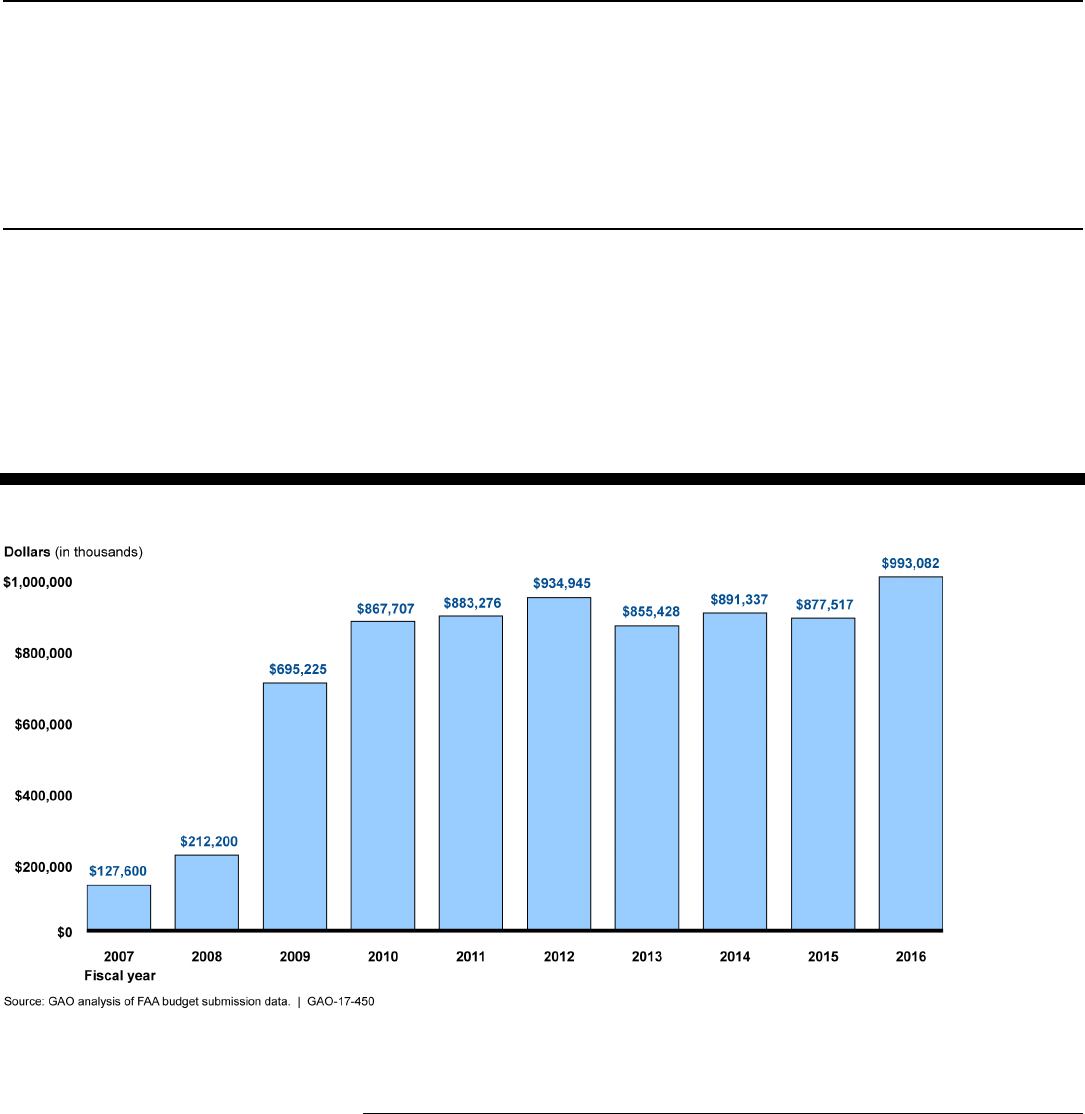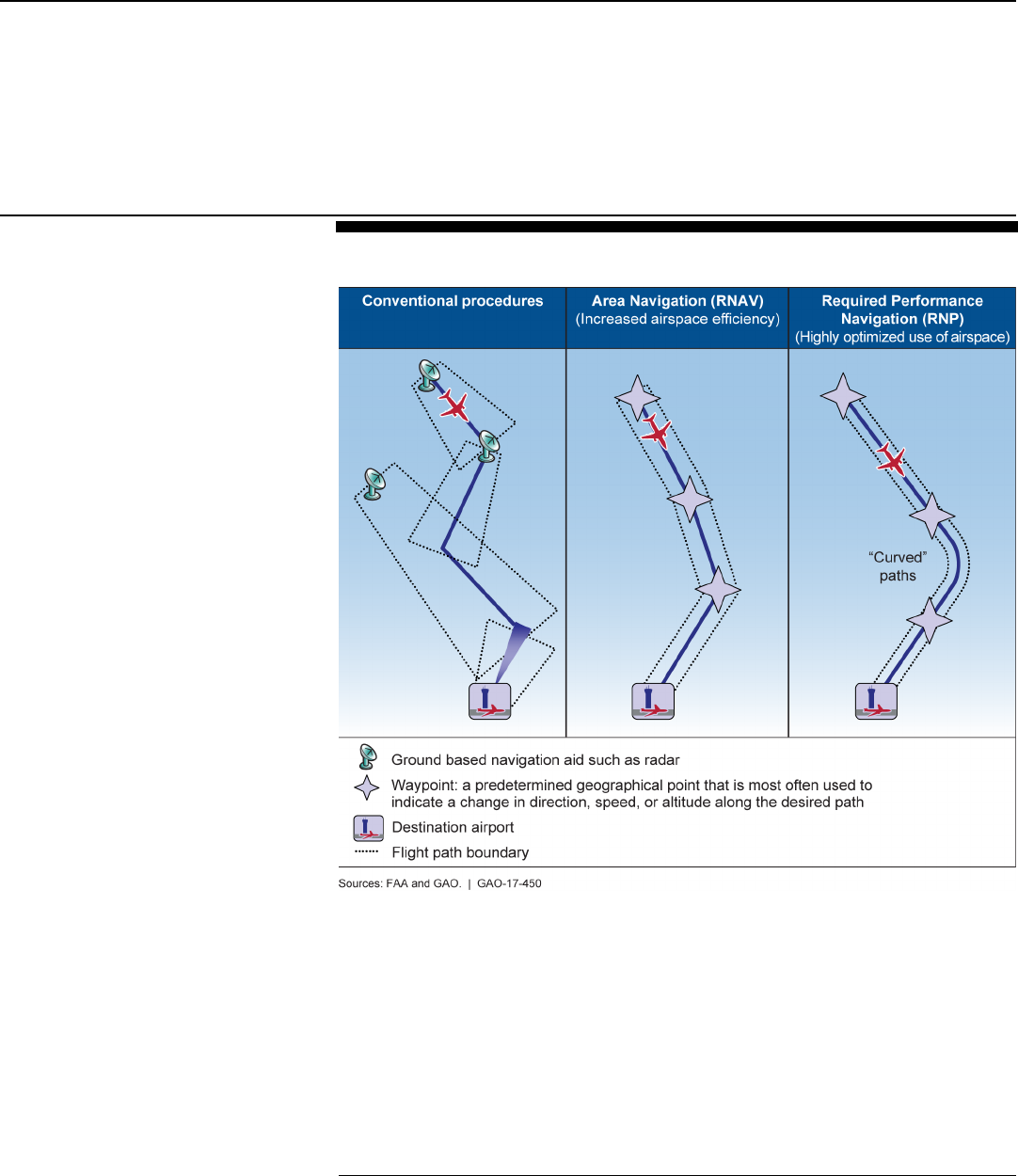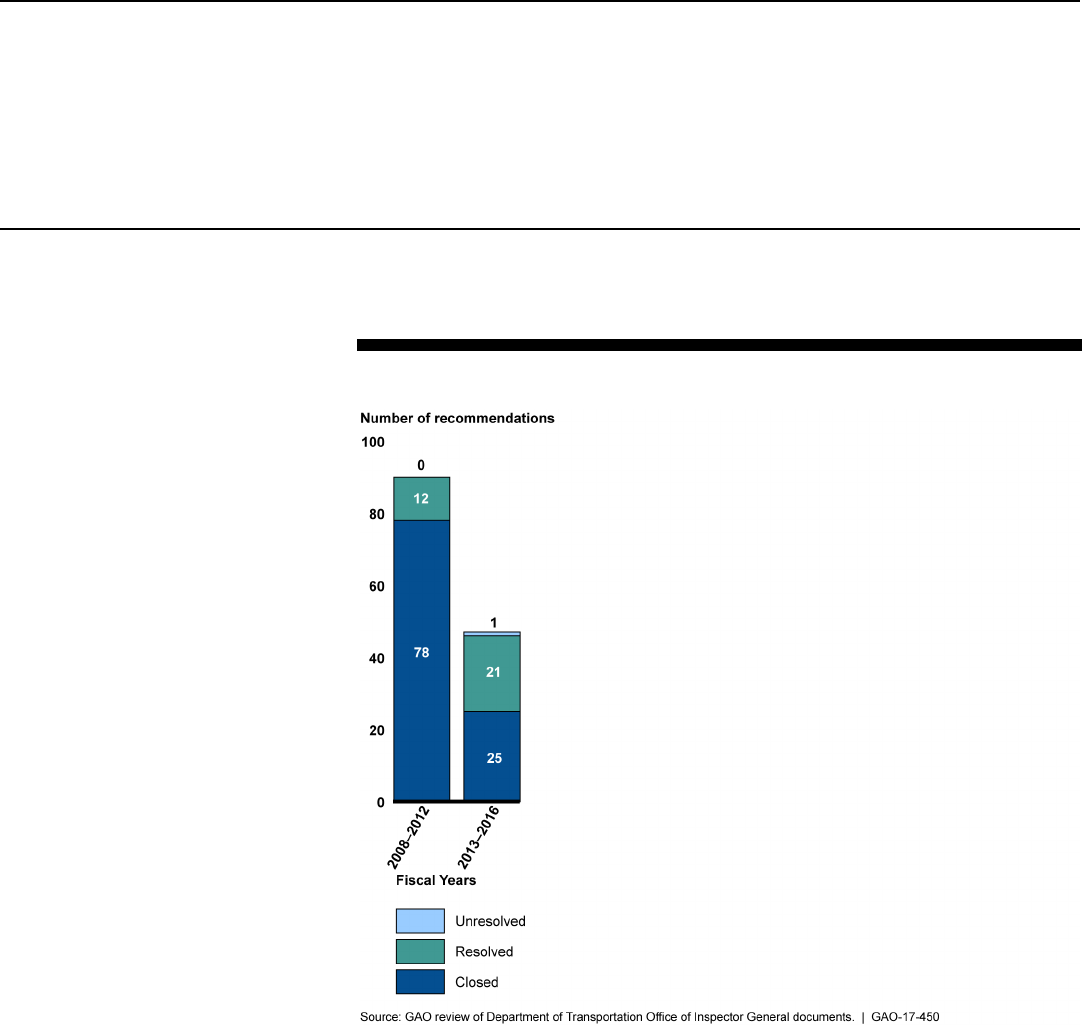
AIR TRAFFIC
CONTROL
MODERNIZATION
Progress and
Challenges in
Implementing
NextGen
Report to Congressional Requesters
August 2017
GAO-17-450
United States Government Accountability Office

United States Government Accountability Office
Highlights of GAO-17-450, a report to
congressional requesters
August 2017
AIR TRAFFIC CONTROL MODERNIZATION
Progress
and Challenges in Implementing
NextGen
What GAO Found
The Federal Aviation Administration (FAA) is implementing the Next Generation
Air Transportation System (NextGen) incrementally and has taken actions to
address challenges to implementation. NextGen has enhanced surface traffic
operations at 39 of the 40 busiest airports in the United States by providing
electronic communications to clear planes for departure, technology that can
expedite clearances and reduce errors. FAA has taken steps to address
challenges such as limited stakeholder inclusion that affected early
implementation of NextGen. For example, FAA established groups of industry
stakeholders and government officials, who worked together to develop
implementation priorities. By 2025, FAA plans to deploy improvements in all
NextGen areas—communications, navigation, surveillance, automation, and
weather. While specific NextGen initiatives and programs have changed over
time, FAA’s 2016 cost estimates for implementing NextGen through 2030 for 1)
FAA and 2) industry—$20.6 and $15.1 billion, respectively—are both within
range of 2007 cost estimates.
Expected Improvements under the Next Generation Air Transportation System
FAA’s challenges as it continues to implement NextGen include uncertainties
regarding future funding; whether aircraft owners equip their aircraft to use
NextGen improvements; potential air traffic control restructuring; FAA’s
leadership stability; and cybersecurity issues. FAA is taking actions to address
challenges within its control by, for example, prioritizing NextGen improvements
and segmenting them into smaller pieces that each require less funding. While it
is not possible to eliminate all uncertainties, FAA has adopted an enterprise risk
management approach to help it identify and mitigate current and future risks that
could affect NextGen implementation. Moreover, FAA has implemented most of
GAO’s related recommendations.
View GAO-17-450. For more information,
contact Gerald
Dillingham, Ph.D., at (202)
512
-2834 or [email protected].
Why GAO Did This Study
FAA is leading the implementation of
NextGen, which is designed to
transition the nation’s ground-based air
traffic control system to one that uses
satellite navigation, automated position
reporting, and digital communications.
Planning for NextGen began in 2003
and in 2007 the effort was estimated to
cost between $29 and $42 billion by
2025. NextGen is intended to increase
air transportation system capacity,
enhance airspace safety, reduce
delays, save fuel, and reduce adverse
environmental effects from aviation.
Given the cost, complexity, and length
of the project, GAO was asked to
review FAA’s NextGen implementation
efforts. This report examines: 1) how
FAA has implemented NextGen and
addressed implementation challenges;
and 2) the challenges, if any, that
remain for implementing NextGen, and
FAA’s actions to mitigate those
challenges.
GAO reviewed FAA documents,
advisory group reports, and NextGen-
related recommendations made to FAA
by GAO and others. GAO interviewed
a non-generalizable sample of 34 U.S.
aviation industry stakeholders,
including airlines, airports, aviation
experts and research organizations,
among others, to obtain their views on
NextGen challenges and FAA’s efforts
to address them. Stakeholders were
selected based on GAO’s knowledge
of the aviation industry and includes
those that have made NextGen-related
recommendations to FAA, among
other things. GAO also interviewed
FAA officials regarding NextGen
implementation and stakeholders’
views.

Page i GAO-17-450 Air Traffic Control Modernization
Letter 1
Background 3
FAA Is Implementing NextGen Incrementally and Has Taken
Various Actions to Address Challenges 6
FAA Faces Various Challenges to Implementing NextGen 23
Agency Comments 35
Appendix I Objectives, Scope, and Methodology 37
Appendix II Select Planning and Implementation Documents 41
Appendix III Selected Programs in the Next Generation Air Transportation System
(NextGen) 44
Appendix IV Status of NextGen’s Recommendations 48
Appendix V Next Generation Air Transportation System’s (NextGen) Activities
Deferred Until After 2030 51
Appendix VI GAO Contact and Staff Acknowledgments 52
Tables
Table 1: Federal Aviation Administration (FAA)’s Portfolios of Next
Generation Air Transportation System (NextGen)
Operational Improvements 9
Table 2: NextGen Mid-Term Implementation Task Force
Recommendation Areas 11
Table 3: List of the 34 Aviation Industry Stakeholders We
Interviewed 38
Table 4: Select Planning and Implementation Documents for the
Next Generation Air Transportation System, 2004-2016 41
Contents

Page ii GAO-17-450 Air Traffic Control Modernization
Table 5: Selected Programs in the Next Generation Air
Transportation System (NextGen) 44
Table 6: Next Generation Air Transportation System’s (NextGen)
Activities Deferred Until After 2030 51
Figures
Figure 1: Improvements to Phases of Flight Expected under the
Next Generation Air Transportation System 6
Figure 2: Metroplex Sites and Their Completion Status, as of
March 2017 13
Figure 3: Federal Funds the Federal Aviation Administration (FAA)
Has Received for Next Generation Air Transportation
System (NextGen) Programs and Activities, Fiscal Years
2007 through 2016 22
Figure 4: The Federal Aviation Administration’s (FAA) Annual
Unmanned Aircraft Systems Sightings, 2014 through
2016 30
Figure 5: Procedures Using Conventional Equipment and
Performance-Based Navigation Technologies 32
Figure 6: Status of GAO NextGen-Related Recommendations
Made to FAA, Fiscal Years 2008–2016 49
Figure 7: Status of Department of Transportation Office of
Inspector General’s NextGen Recommendations Made to
FAA, Fiscal Years (FY) 2008–2016 50
Abbreviations
ADS-B Automatic Dependent Surveillance-Broadcast
AIMM Aeronautical Information Management Modernization
ATC air traffic control
ATN Aeronautical Telecommunications Network
ATO Air Traffic Organization

Page iii GAO-17-450 Air Traffic Control Modernization
AVS Office of Aviation Safety
CATM-T Collaborative Air Traffic Management-Technologies
CSS-Wx Common Support Services-Weather
CIO Chief Information Officer
DAC Drone Advisory Committee
Data Comm Data Communications
DOT Department of Transportation
DOT OIG Department of Transportation’s Office of Inspector General
FAA Federal Aviation Administration
F&E facilities and equipment
ERAM En Route Automation Modernization
ERM Enterprise Risk Management
GPS Global Positioning System
JPDO Joint Planning and Development Organization
NAC NextGen Advisory Committee
NAS National Airspace System
NextGen Next Generation Air Transportation System
NPS NextGen Performance Snapshots
NVS National Airspace System Voice System
NWP NextGen Weather Processor
OIG Office of Inspector General
OMB Office of Management and Budget
PBN Performance-Based Navigation
RE&D research, engineering and development
RTCA formerly known as the Radio Technical Commission for
Aeronautics
SOA Service Oriented Architecture
SWIM System Wide Information Management
TAMR Terminal Automation Modernization and Replacement
TBFM Time Based Flow Management
TFDM Terminal Flight Data Manager
TMA Traffic Management Advisor
UAS unmanned aircraft systems
Wake Recat Wake Turbulence Re-Categorization
This is a work of the U.S. government and is not subject to copyright protection in the
United States. The published product may be reproduced and distributed in its entirety
without further permission from GAO. However, because this work may contain
copyrighted images or other material, permission from the copyright holder may be
necessary if you wish to reproduce this material separately.

Page 1 GAO-17-450 Air Traffic Control Modernization
441 G St. N.W.
Washington, DC 20548
August 31, 2017
The Honorable Bill Shuster
Chairman
The Honorable Peter DeFazio
Ranking Member
Committee on Transportation and Infrastructure
House of Representatives
The Honorable Frank LoBiondo
Chairman
The Honorable Rick Larsen
Ranking Member
Subcommittee on Aviation
Committee on Transportation and Infrastructure
House of Representatives
The U.S. National Airspace System (NAS) handles nearly 70,000 flights a
day and is generally considered the safest, busiest and most complex
airspace system in the world.
1
Key aviation stakeholders—the Federal
Aviation Administration (FAA), airlines, airports, general aviation,
business aviation, aircraft manufacturers, and aviation professionals—
work together to ensure these results. As part of this effort, FAA is leading
the development of the Next Generation Air Transportation System
(NextGen), a complex, long-term initiative that will transition the current
ground-based radar air-traffic control system to a system based on
satellite navigation, automated position reporting, and digital
communications. NextGen is intended to, among other things, increase
air transportation system capacity, enhance airspace safety, reduce
delays experienced by airlines and passengers, save fuel, and reduce
adverse environmental impacts from aviation. Full implementation of
NextGen requires investment by the federal government through FAA, as
well as by airlines in new technologies and the development of new
policies and procedures.
1
The National Airspace System is a shared network of U.S. airspace; air navigation
facilities, equipment, and services; airports or landing areas; aeronautical charts,
information, and services; rules, regulations, and procedures; technical information; and
manpower and material.
Letter

Page 2 GAO-17-450 Air Traffic Control Modernization
In December 2003, Congress passed the Vision 100—Century of Aviation
Reauthorization Act, which created the Joint Planning and Development
Organization (JPDO) within FAA to plan for and coordinate an
interagency effort to transition to NextGen by 2025.
2
However, FAA has
been largely responsible for implementing the policies and systems
necessary for NextGen to become operational. In 2014, with NextGen
implementation underway, Congress ended funding for JPDO, and FAA’s
Interagency Planning Office assumed lead responsibilities for
coordinating FAA’s NextGen implementation with other agencies.
3
We have monitored and reported on NextGen since its inception.
4
After
more than a decade of planning and implementation, you asked us to
review the status of FAA’s NextGen implementation efforts. This report
examines: (1) how FAA has implemented NextGen and addressed
implementation challenges; and (2) the challenges, if any, that remain for
implementing NextGen, and FAA’s actions to mitigate those challenges.
To address these objectives, we reviewed FAA planning documents for
NextGen and FAA reports and briefings related to ongoing NextGen
efforts. We also assessed current cost estimates for implementing
NextGen through 2030 and compared them to 2007 estimates from
JPDO. We reviewed reports and NextGen-related recommendations
issued by GAO, the Department of Transportation’s (DOT) Office of
Inspector General (DOT OIG), and NextGen advisory groups; and
assessed FAA’s efforts to address these recommendations. We
interviewed FAA officials with a role in implementing NextGen, including
2
FAA’s partner agencies in the JPDO included the Department of Transportation, the
Department of Defense, the Department of Homeland Security, the Department of
Commerce, the National Aeronautics and Space Administration, and the Office of Science
and Technology Policy in the Executive Office of the President. Vision 100—Century of
Aviation Reauthorization Act, Pub. L. No. 108-176, §§ 709-710, 117 Stat. 2490, 2582
(2003).
3
The Interagency Planning Office is located within the Office of NextGen and coordinates
with agencies such as the Departments of Defense and Homeland Security.
4
See, for example, GAO, National Airspace System: Transformation Will Require Cultural
Change, Balanced Funding Priorities, and Use of All Available Management Tools,
GAO-06-154 (Washington, D.C.: Oct. 14, 2005); GAO, NextGen Air Transportation
System: FAA’s Metrics Can Be Used to Report on Status of Individual Programs, but Not
of Overall NextGen Implementation or Outcomes, GAO-10-629 (Washington, D.C.: July
27, 2010); GAO, Next Generation Air Transportation System: Improved Risk Analysis
Could Strengthen Global Interoperability Efforts, GAO-15-608 (Washington, D.C.: July 29,
2015).

Page 3 GAO-17-450 Air Traffic Control Modernization
officials within the NextGen Office and its Interagency Planning Office, the
Office of Aviation Safety (AVS), and the Air Traffic Organization (ATO).
To obtain a diverse set of views, we also interviewed 34 stakeholders
using open-ended questions to obtain their perspectives on efforts FAA
has made to address challenges that have affected NextGen
implementation. These 34 stakeholders consisted of a non-probability
sample of aviation experts and officials from airlines, airports, former FAA
officials, research and development organizations, general aviation
associations, labor unions and professional associations, and
manufacturers and service providers. We created an initial list of
stakeholders using internal knowledge of the aviation industry. We further
developed the list of stakeholders by reviewing NextGen-related literature
and identifying industry stakeholders that have made NextGen-related
recommendations to FAA. To determine the common themes that we are
reporting on, we conducted a content analysis of the interviewees’
responses. The results of our interviews are not generalizable to all
industry stakeholders. For more information on our scope and
methodology, including a listing of FAA divisions and industry
stakeholders we interviewed, see appendix I.
We conducted this performance audit from November 2015 to August
2017 in accordance with generally accepted government auditing
standards. Those standards require that we plan and perform the audit to
obtain sufficient, appropriate evidence to provide a reasonable basis for
our findings and conclusions based on our audit objectives. We believe
that the evidence obtained provides a reasonable basis for our findings
and conclusions based on our audit objectives.
FAA has pursued several different modernization efforts for air traffic
control (ATC) since FAA’s creation by the Federal Aviation Act of 1958.
5
These efforts to upgrade the air-traffic control system included the
installation of a semi-automated air-traffic control system beginning in the
mid-1960s and an air traffic control modernization program beginning in
5
Federal Aviation Act of 1958, Pub. L. No. 85-726, § 301, 72 Stat. 731, 744 (1958). In
1966, the previously independent Federal Aviation Agency that the Act created was
renamed the Federal Aviation Administration and made part of the new Department of
Transportation. Pub. L. No. 89-670, § 3(e)(1), 80 Stat. 931, 932 (1966).
Background
FAA’s Early Modernization
Efforts for Air Traffic
Control

Page 4 GAO-17-450 Air Traffic Control Modernization
1981. The 1981 modernization program was intended to replace and
upgrade the equipment and facilities of the NAS to meet an expected
increase in traffic volume, enhance the margin of air safety, and increase
the efficiency of the air-traffic control system. The centerpiece of the
program was the Advanced Automation System, which would replace
computer hardware and software and controller work stations at tower,
terminal, and en-route facilities.
FAA restructured the automation program in 1994 after the estimated cost
to deploy it had tripled, capabilities were shown to be significantly less
than promised, and delays were expected to run nearly a decade.
6
In
1995, we placed FAA’s air traffic control modernization efforts on our
watch list of high-risk federal programs due to the cost, complexity,
criticality to FAA’s mission, and problematic history.
7
By 2003, the
estimated cost of FAA’s air-traffic control modernization efforts had grown
from $12 billion to $51 billion.
In the early 2000s, the U.S airspace system was experiencing significant
congestion and delays, with about one in every four flights delayed.
Additionally, forecasts called for a possible tripling of air traffic by 2025,
which raised concerns about the air-traffic control system’s ability to
handle demand. In December 2003, Congress passed the Vision 100—
Century of Aviation Reauthorization Act, which created the JPDO within
FAA to plan for and coordinate a transition to NextGen by 2025.
8
Congress’s goals for NextGen were to improve the level of safety,
security, efficiency, quality, and affordability of the NAS and aviation
services; take advantage of data from emerging technologies and
integrate data streams from multiple sources; and accommodate and
encourage substantial growth in domestic and international
transportation, among other things. Congress assigned the JPDO the
6
This restructuring included cancelling segments of the initial automation program, scaling
back others, and ordering the development of less costly alternatives. Three of five
segments of the Advanced Automation System were cancelled, one segment was scaled
back, and another segment was unaffected.
7
GAO removed FAA’s air traffic control modernization efforts from the high-risk list in 2009
because of its progress in addressing most of the root causes of its past problems and its
commitment to sustaining progress in the future. GAO, High Risk Series: An Update,
GAO-09-271 (Washington, D.C.: January 2009).
8
Vision 100—Century of Aviation Reauthorization Act, Pub. L. No. 108-176, §§ 709-710,
117 Stat. 2490, 2582 (2003).
NextGen

Page 5 GAO-17-450 Air Traffic Control Modernization
responsibility to develop an integrated plan for NextGen and facilitate
collaboration between FAA and other federal agencies on NextGen
efforts. Since passage of the Vision 100 Act, NextGen has evolved from a
high-level vision developed by the JPDO to detailed plans currently being
implemented by FAA.
9
See appendix II for more detail on FAA’s planning
and implementation documents for NextGen.
NextGen is a system of systems designed to improve operations in all
phases of a flight, through the replacement of the legacy radar-based air
traffic control system with a satellite-based system that includes digital
communications, among other improvements. NextGen includes a variety
of programs that deliver specific improvements to the NAS. See figure 1
below for some of the improvements to the phases of flight that NextGen
is expected to deliver. For example, under enhanced-surface-traffic
operations, a service provided by FAA’s Data Communications program
allows an air traffic controller to send flight-departure clearance
instructions to aircraft electronically, which can expedite clearances and
reduce communication errors. Under an improvement to streamline arrival
management, performance-based navigation allows aircraft equipped
with appropriate technology to fly precise paths at reduced power, which
saves time, conserves fuel, and reduces exhaust emissions. In addition,
FAA is deploying some programs that are necessary to implement
NextGen programs. For example, the En Route Automation
Modernization (ERAM) program replaced the computer system used by
air traffic controllers at en route centers, a step that was necessary to
deploy some NextGen programs.
10
9
The Consolidated Appropriations Act of 2014 did not include funding for the JPDO,
resulting in its closure. Pub. L. No. 113-76, 128 Stat. 5 (2014). FAA has created an
Interagency Planning Office within FAA to replace certain functions of the JPDO and
coordinate federal investment in NextGen across agencies.
10
En route centers are air traffic control facilities responsible for guiding aircraft as they
travel between airports.

Page 6 GAO-17-450 Air Traffic Control Modernization
Figure 1: Improvements to Phases of Flight Expected under the Next Generation Air Transportation System
FAA is implementing NextGen incrementally through six NextGen-related
areas—communications, automation, navigation, surveillance, weather,
and foundational programs. FAA has faced challenges in including
stakeholders and in measuring and reporting on NextGen progress. In
response, FAA has encouraged the formation of groups of stakeholders
to advise it on implementing NextGen and measuring its progress, and
has worked to incorporate industry preferences into its implementation of
NextGen. For example, FAA is deploying new navigation procedures in
“metroplexes”— geographic areas covering several airports that serve
major metropolitan areas—following a recommendation from a
government and industry task force. FAA has also developed a website
that reports on outcome-based performance metrics for NextGen. FAA
plans to implement the concepts that will transform the NAS to a NextGen
system by 2025, and current total cost estimates for NextGen are within
the JPDO’s 2007 estimates.
In the late 1990s, building on lessons learned from previous air traffic
control modernization efforts and recommendations from stakeholders,
FAA Is Implementing
NextGen
Incrementally and
Has Taken Various
Actions to Address
Challenges
Strategy for Implementing
NextGen

Page 7 GAO-17-450 Air Traffic Control Modernization
FAA shifted its strategy for air traffic control modernization. In contrast to
previous modernization efforts, in which FAA sought to build highly
complex software-intensive systems all at once, FAA adopted a phased
approach to modernization that allowed FAA to make mid-course
corrections and avoid costly late-stage changes. JPDO later adopted this
approach for developing and refining its enterprise architecture—a
technical description of the NextGen system that was designed to provide
a common tool for planning the complex, interrelated systems that would
make up NextGen. According to FAA officials we interviewed, the
development and implementation of NextGen is an iterative and
evolutionary process. However, some stakeholders told us that FAA had
originally described NextGen as a transformative initiative. A report from a
2015 National Academy of Sciences study commented that NextGen
meant different things to different people, from a wide-ranging
transformational vision to a much more concrete set of phased
incremental changes to various parts of the NAS, and recommended
resetting expectations. The study committee concluded that NextGen
today is primarily an incremental modernization effort.
The report also
noted that given the continuing rapid pace of technological evolution and
ongoing changes in what is demanded of the NAS, the NextGen effort is
properly seen as an ongoing process, punctuated by particular efforts
focused on particular capabilities.
11
According to FAA officials, NextGen
can be both incremental and result in a transformation.
FAA has begun developing and deploying elements of many NextGen
communications, automation, navigation, surveillance, and weather
programs, as well as foundational programs on which NextGen
improvements depend. A short overview of these six NextGen-related
program areas can be found below. See appendix III for further
information about select NextGen programs.
• Foundational programs to provide the infrastructure necessary to
deploy NextGen programs. For example, the Terminal Automation
Modernization and Replacement (TAMR) program includes updates to
air traffic control systems to help controllers manage air traffic.
• Communications programs to enhance communication and
information sharing in the NAS. This area includes programs such as
Data Communications, which will supplement the voice
11
National Research Council, A Review of the Next Generation Air Transportation System:
Implications and Importance of System Architecture (Washington, DC: 2015).

Page 8 GAO-17-450 Air Traffic Control Modernization
communications currently used to relay information between air traffic
controllers and aircraft with pre-scripted email-like messages.
• Navigation programs that use more efficient routes and procedures to
save fuel, reduce flight times, increase traffic flow and capacity, and
reduce exhaust emissions. This area includes programs such as
Performance-Based Navigation (PBN), which provides new, more
efficient aircraft flight routes and procedures that primarily use
satellite-based navigation.
• Surveillance programs to provide more precise tracking of aircraft,
vehicles, and other objects to air traffic controllers and pilots. This
area includes programs such as Automatic Dependent Surveillance-
Broadcast (ADS-B), which uses Global Positioning System (GPS)
satellites to determine an aircraft’s location, speed, and other data.
• Automation programs to enhance air traffic control efficiency, reduce
costs, and provide traffic flow management solutions. This area
includes programs such as Time Based Flow Management, which is
designed to optimize the flow of aircraft as they arrive in or depart
from congested airspace and airports.
• Weather programs to manage and disseminate weather information,
help identify safety hazards, and provide support for strategic traffic
flow management.
12
This area includes programs such as Common
Support Services-Weather, which will enable access to standardized
weather information.
Some NextGen improvements have already been deployed. For example,
Data Communications departure clearance services have been deployed
at 55 airports—all of the locations for the first phase of the Data
Communications program, including 39 of the 40 busiest commercial
airports in the United States.
13
FAA has segmented the implementation of
some of its NextGen programs into time frames during which FAA will
implement certain portions of the programs. By segmenting
implementation, FAA divides each program into defined parts that require
less funding than the entire program.
12
Strategic traffic flow management (as opposed to tactical traffic flow management)
refers to longer-term, 2-8 hour traffic management planning efforts at a larger scale,
perhaps regional or national rather than local.
13
We defined the “busiest airports” as those with the most passengers boarding at each
airport in 2015.

Page 9 GAO-17-450 Air Traffic Control Modernization
In many cases, achieving the desired NextGen outcomes depends on the
successful implementation of multiple programs or capabilities. For
example, more efficient air traffic control routes may provide limited
benefits if air traffic controllers do not have access to tools to better
manage airborne traffic. To help manage the implementation of NextGen
improvements across programs, FAA has organized the operational
improvements—specific operational changes to the NAS, such as the
implementation of improved air traffic control procedures—into portfolios.
This portfolio-based approach views NextGen as an integrated effort
rather than a series of independent programs. See table 1 below for a list
and description of FAA’s 11 implementation portfolios.
Table 1: Federal Aviation Administration (FAA)’s Portfolios of Next Generation Air
Transportation System (NextGen) Operational Improvements
Portfolio
Description
Improved Surface
Operations
Seeks to improve safety, efficiency, and flexibility on the
airport surface—on the ground at airports—by
implementing new traffic management capabilities for
pilots and controllers using shared surface movement
data.
Improved Approaches and
Low-Visibility Operations
Includes capabilities designed to increase airport access
and flexibility through procedural changes, improved
aircraft capabilities, and improved precision approach
guidance—navigation guidance given to pilots to guide an
aircraft on its descent to a runway.
Improved Multiple Runway
Operations
Seeks to improve access to closely spaced parallel
runways to enable more arrival and departure operations.
Performance-Based
Navigation
Uses navigation technologies to improve access and
flexibility in the National Airspace System (NAS) and
provide more efficient aircraft routes.
Time-Based Flow
Management
Enhances NAS efficiency by using the capabilities of the
Traffic Management Advisor decision support tool, which
assigns times when aircraft destined for the same airport
should cross certain points in order to reach the
destination airport at a specific time and in an efficient
order. Uses time instead of distance to help controllers
sequence aircraft.
Collaborative Air Traffic
Management
Coordinates decision making by flight planners and FAA
traffic managers to improve NAS efficiency, provide
greater flexibility to flight planners, and make the best use
of available airspace and airport capacity.
Separation Management
Provides air traffic controllers with tools and procedures to
separate aircraft. Safely reducing separation between
aircraft through the capabilities in this portfolio may
improve capacity, efficiency, and safety in the NAS.

Page 10 GAO-17-450 Air Traffic Control Modernization
Portfolio
Description
On-Demand NAS
Information
Provides flight planners, air traffic controllers, traffic
managers, and flight crews with consistent and complete
information related to changes in various areas of the
NAS, such as temporary flight restrictions, equipment
outages, and runway closures.
Environment and Energy
Seeks to mitigate air quality, climate, energy, noise, and
water quality concerns from aviation through improved
scientific knowledge and integrated modeling; air traffic
modernization and operational improvements; new aircraft
technology; sustainable alternative aviation fuels; and
policies, environmental standards, and market-based
measures.
System Safety
Management
Uses data acquisition, storage, analysis, and modeling
capabilities being developed to ensure that new
capabilities either improve or maintain current safety levels
while simultaneously improving capacity and efficiency in
the NAS.
NAS Infrastructure
Provides research, development, and analysis of
capabilities that depend on and affect activities in more
than one NextGen portfolio.
Source: GAO review of GAO and Federal Aviation Administration documents. | GAO-17-450
In 2008, many of the aviation stakeholders we interviewed told us that
while they felt they were provided the opportunity to participate in
NextGen’s planning, many were not satisfied with the impact or outcome
of their participation. Some of these stakeholders expressed concern that
their input was not included in the development of planning documents
and other products, and that issues were not addressed or incorporated
in NextGen plans.
14
This participation is critical to NextGen’s
14
GAO, Next Generation Air Transportation System: Status of Systems Acquisition and
the Transition to the Next Generation Air Transportation System, GAO-08-1078
(Washington, D.C.: September 11, 2008).
Limited Stakeholder
Inclusion and
Communications Affected
Early Implementation, But
FAA Has Taken Steps to
Address These
Challenges
Evolution of Stakeholder
Inclusion

Page 11 GAO-17-450 Air Traffic Control Modernization
implementation because NextGen depends heavily on airlines’ and other
stakeholders’ investments in NextGen technology and training.
The need for stakeholder buy-in and investment led FAA in 2009 to
request RTCA to form a task force of government and industry
stakeholders.
15
This task force —called the NextGen Mid-Term
Implementation Task Force—was asked to recommend NextGen
improvements that could be implemented with existing technologies in the
“midterm,” which was defined as lasting through 2018. In 2009, this task
force issued its recommendations to FAA; they prioritized operational
capabilities in six areas: surface, runway access, metroplex, cruise,
access to the NAS, and cross-cutting—recommendations that cut across
the previous five areas (see table 2).
16
FAA accepted the Task Force
recommendations and incorporated them into its annual NextGen
implementation plans.
Table 2: NextGen Mid-Term Implementation Task Force Recommendation Areas
Recommendation
Area
Description
Surface
Improving surface traffic management—the management of
traffic on the ground at airports—to reduce delays and enhance
safety, efficiency, and situational awareness through capture
and dissemination of surface operations data to pilots,
controllers, user operations centers, and other destinations.
Runway Access
Increasing runway access, especially in low visibility, to
converging, intersecting, and closely-spaced parallel runways
by leveraging potential capacity gains from accurate and
predictable flight paths, as well as enhanced surveillance
methods.
Metroplex
Relieving congestion and delays at major metropolitan areas’
airports, ine
ffi
ciencies at satellite airports, and surrounding
airspace by instituting FAA and industry teams that focus on
quality of implementation at each location and minimizing
conflicts between the operations of adjacent airports.
15
RTCA (formerly called the Radio Technical Commission for Aeronautics) is a public-
private partnership that provides a forum for developing consensus among competing
interests on aviation modernization issues, including providing industry recommendations
for FAA.
16
Surface refers to operations on the ground at airports. Cruise operations occur between
the climb and descent phases of flight. A metroplex is a geographic area covering several
airports that serve major metropolitan areas.

Page 12 GAO-17-450 Air Traffic Control Modernization
Recommendation
Area
Description
Cruise
Improving efficiency of cruise operations—operations that
occur between the climb and descent phases of flight—by
increasing the ability to disseminate real-time airspace status
and schedules; improving flow management to better utilize
time-based metering—delivering aircraft to a specific place at a
specific time—and flight operator capabilities; and
implementing data communications between air traffic control
systems and aircraft to more e
ff
ectively manage tra
ffi
c and
exchange routing and clearance information.
Access to the National
Airspace System
Improving access to and services provided at airports other
than the Operational Evolution Partnership airports—the 35
U.S. airports with the most significant commercial activity—and
to low altitude, non-radar airspace by implementing more
precision-based approaches and departures, along with the
expansion of surveillance services to areas not currently under
radar surveillance.
Cross-Cutting
Recommendations that cut across the previous five areas,
including using data communications to enable more efficient
use of capacity in the National Airspace System, increasing the
ability to adapt to changing conditions through improved
dissemination of reroutes around weather and congestion,
creating a system for managing air traffic that leverages new
technologies and collaboration with the users, and
implementing integrated solutions to tra
ffi
c flow problems.
Source: GAO analysis of GAO, RTCA, and FAA documents. | GAO-17-450
In response to the task force recommendations, FAA has focused its
operational improvement efforts on key airports and metropolitan areas.
Specifically, through the Optimization of Airspace and Procedures in the
Metroplex (Metroplex) initiative, which began in fiscal year 2010, FAA has
focused on airspace redesign and deploying PBN procedures—
procedures that primarily use satellite-based navigation and equipment
on aircraft to navigate with greater precision—in metroplexes. These
metroplexes have a large effect on the overall efficiency of the NAS,
because congestion or delays at one metroplex can affect NAS
operations in other parts of the country. These metroplexes are shown in
figure 2.

Page 13 GAO-17-450 Air Traffic Control Modernization
Figure 2: Metroplex Sites and Their Completion Status, as of March 2017
a
The Core 30 airports are a set of airports in major metropolitan areas with the highest volume of
traffic.
b
FAA’s Optimization of Airspace and Procedures in the Metroplex (Metroplex) initiative focuses on
airspace redesign and deployment of performance-based navigation procedures in metroplexes—

Page 14 GAO-17-450 Air Traffic Control Modernization
geographic areas covering several airports that serve major metropolitan areas. These procedures
primarily use satellite-based navigation and equipment on aircraft to navigate with greater precision.
c
FAA “paused” work on the Phoenix metroplex in October 2015 due to legal action brought by the City
of Phoenix, and does not yet have plans to resume it.
In fiscal year 2013, FAA planned to complete projects at 10 metroplexes
by fiscal year 2016, but as of March 2017 FAA had completed projects at
only 4 metroplexes.
17
FAA considers a metroplex “completed” when,
among other things, it deploys new PBN procedures and when all air
traffic controllers are trained on the new procedures. According to FAA,
several factors caused the delay. FAA decided to implement ERAM
before addressing metroplexes because ERAM is required for some
NextGen operations. As a result, some Metroplex projects were delayed
until ERAM was implemented.
18
For example, the Charlotte and Atlanta
metroplexes were delayed from April 2014 until August 2015 while the
Atlanta Air Route Traffic Control Center implemented ERAM. In addition,
FAA changed the Metroplex program in 2015 to include enhanced
community involvement and outreach activities in Metroplex projects. This
change further contributed to delays. For example, according to FAA, the
introduction of the community involvement initiative caused a 15 month
delay in the Cleveland/Detroit Metroplex project. Under FAA’s current
community involvement strategy, a new Metroplex project would take
about 7 months longer to complete because of community involvement
activities. Further, according to FAA, sequestration and the 2013
government shutdown caused some delays due to employee furloughs
and travel restrictions. In addition to the 4 completed projects, 8 other
Metroplex projects are in various stages. While FAA plans to complete
the current set of 12 Metroplex projects by fiscal year 2019, FAA “paused”
work at one metroplex—Phoenix—in October 2015, due to legal action
brought by the City of Phoenix over noise created by new PBN
procedures. As of March 2017, FAA did not have plans to resume that
work.
17
FAA originally planned to complete 21 Metroplex projects by the end of fiscal year 2016,
but following a 2011 schedule review determined that neither it nor the aviation community
would have the personnel to stay on that schedule. In response, FAA reduced the number
of metroplexes and combined some of them into a list of 13 Metroplex locations. FAA later
deferred three of those locations (Boston, Chicago, and Memphis) and added two
locations (Denver and Las Vegas), resulting in the current list of 12 active metroplexes.
18
In 2012, we reported that insufficient stakeholder involvement and underestimates of the
complexity of software development had led to delays in ERAM and an estimated cost
increase of about $330 million. GAO-12-223. FAA attributed another delay in ERAM’s
completion (from August 2014 to March 2015) to the impact of sequestration.

Page 15 GAO-17-450 Air Traffic Control Modernization
At completed metroplexes, not all aircraft are flying PBN procedures.
Although PBN procedures generally provide more efficient flight routes,
controllers may continue to route air traffic on conventional routes for a
number of reasons. For example, some aircraft may not have the proper
equipment to use the new procedure. Further, some airline officials we
interviewed reported receiving fewer benefits than expected from FAA’s
implementation of PBN. For example, officials at one airline told us that,
at one metroplex, FAA’s changes have led to that airline’s flying a less
efficient route into one airport, a route that requires its aircraft to use more
fuel and time to land at that airport.
Some stakeholders have called on FAA to include New York in its
Metroplex plans, due to its congestion and impact—such as flight
delays—on the rest of the NAS, as we have previously reported.
19
In
2013, we reported that FAA chose to exclude the New York/Philadelphia
metroplex because FAA did not want to initiate a new environmental
review process. FAA told us in 2017 that the agency plans to focus on the
northeast in the future, but does not have a current plan to implement
Metroplex improvements there.
At FAA’s request, RTCA established the NAC to provide advice on
NextGen implementation issues.
20
FAA designated the NAC to develop
aviation stakeholder priorities for NextGen implementation. These
priorities included both the national implementation of NextGen as well as
specific locations (such as airports) for NextGen improvements. In 2012,
the Integrated Capabilities Work Group of the NAC developed priority
operational improvements for major airports and metroplexes in the
midterm.
21
These priority improvements included capabilities such as
deploying PBN procedures that allow aircraft to take a more direct route
into and out of airports, which FAA expects will save both time and fuel.
19
GAO, NextGen Air Transportation System: FAA Has Made Some Progress in Mid-Term
Implementation, but Ongoing Challenges Limit Expected Benefits, GAO-13-264
(Washington, D.C.: April 8, 2013).
20
The NAC is comprised of a cross-section of senior executives from airlines, airports,
general aviation, and manufacturers, with the support of aviation stakeholders from the
federal government and international organizations. NAC members also include
representatives from pilot and air traffic controller unions.
21
The NAC includes a Subcommittee comprised of members with broad knowledge and
expertise related to NextGen. The NAC establishes working groups to accomplish
specific tasks.

Page 16 GAO-17-450 Air Traffic Control Modernization
In 2014, FAA and the NAC issued a Joint Implementation Plan in which
FAA and industry described a set of activities that FAA and the aviation
community were committed to accomplishing within the next 3 years.
These activities covered four focus areas: data communications, multiple
runway operations, PBN, and surface operations and data sharing.
According to FAA, by the end of 2016, FAA had implemented 124 of 128
NextGen commitments it made for 2014 through 2016. For example, FAA
had deployed the System Wide Information Management (SWIM) Surface
Visualization Tool at five terminal radar-approach control facilities. This
tool provides air traffic controllers—who are not located in the airport
tower—with a real-time picture of airport surface traffic.
22
FAA and the
NAC have agreed to update the Joint Implementation plan annually and
develop rolling plans every 2 years to re-examine the needs of the NAS
and its users and to add milestones. FAA had an additional 57
commitments for 2017 through 2019 as of the beginning of 2017, and
industry had an additional 17 commitments for the same time period. In
addition to these commitments, in February 2017, the NAC voted to make
the Northeast Corridor – which stretches from Washington, D.C to
Boston, MA and includes the New York area – the fifth area of NAC
focus.
Concurrent with the work and recommendations of the RTCA’s Mid-Term
Implementation Task Force and the NAC, the DOT OIG and we
conducted reviews of NextGen. As a result of those reviews, from fiscal
year 2008 through fiscal year 2016 the DOT OIG and we issued 137 and
47 recommendations, respectively, aimed at improving the
implementation of NextGen. Our analysis shows that FAA has
implemented most of the recommendations related to NextGen programs
from us and DOT OIG since fiscal year 2008. More specifically, FAA has
implemented 39 of our 47 recommendations (83 percent), 6
recommendations are in process (13 percent), and 2 remain open (4
percent).
23
Additionally, DOT OIG has closed as implemented 103 of its
137 recommendations (75 percent) that we determined to be related to
22
SWIM enables sharing of air traffic management-related information among diverse
systems, and offers a single point of access for aviation data.
23
Recommendations that are in process are those for which FAA has submitted
information to close the recommendation, but either the information has not been fully
reviewed, or we determined it does not yet sufficiently address our recommendation.

Page 17 GAO-17-450 Air Traffic Control Modernization
NextGen.
24
See appendix IV for an overview of the status of
recommendations DOT OIG and we made related to NextGen.
FAA has faced challenges in consistently communicating the status of
NextGen’s implementation. In 2010, we found that while FAA had broad
goals for NextGen, such as increasing capacity and reducing noise and
emissions, it had not developed specific goals and outcome-based
performance metrics to track the impact of and benefits realized from the
entire NextGen endeavor.
25
At that time, we recommended that FAA
develop an action plan to agree with stakeholders on a list of specific
goals and outcome-based performance metrics for NextGen. FAA
developed a set of performance metrics, which were used as a starting
point with industry collaboration, and aligned them with NextGen and
agency-wide goals.
Additionally, FAA launched the NextGen Performance Snapshots (NPS)
website to compare key NextGen initiatives with performance outcomes
at locations where NextGen technologies have been deployed. For
example, with some NextGen initiatives already deployed, FAA tracks the
measures and reports on airport performance at the Core 30 airports—a
set of airports in major metropolitan areas with the highest volume of
traffic–where NextGen technologies have been implemented. The agency
plans to continue to update the NPS with additional metrics as they
mature. Further, the NAC created a Joint Analysis Team which has
developed outcome measures for deploying certain NextGen capabilities.
For example, the team has measured the effect of efforts to update
standards for separation between and among aircraft on the efficiency of
operations at airports in Charlotte, Chicago, Indianapolis, and
Philadelphia. The objective of this capability is to decrease the separation
between and among aircraft and thereby allow more takeoffs and
landings and greater efficiency and capacity for airports. FAA officials told
us that FAA continues to work with industry partners to ensure that FAA is
validating and verifying implementation progress of NextGen technology
and reporting successes and beneficial effects. However, some
stakeholders told us that FAA continues to focus on outputs, such as the
24
DOT OIG closes a recommendation after the Department of Transportation has agreed
with the recommendation, has taken appropriate corrective action, and has provided DOT
OIG with sufficient supporting evidence to demonstrate that the action was taken.
25
GAO, NextGen Air Transportation System: FAA’s Metrics Can Be Used to Report on
Status of Individual Programs, but Not of Overall NextGen Implementation or Outcomes,
GAO-10-629 (July 27, 2010).
Measuring and Reporting
Implementation Status

Page 18 GAO-17-450 Air Traffic Control Modernization
number of ADS-B ground stations deployed, instead of outcomes, such
as improvements in safety, capacity, or efficiency.
According to FAA officials, current segments of NextGen programs are
generally on schedule, and FAA documents indicate that FAA plans to
implement the concepts that will complete the transformation of the NAS
to a NextGen system by 2025.
26
According to FAA, these timeframes are
updated at least annually. FAA also has an Integrated Master Schedule
for key NextGen activities; this schedule is updated at least every 3
months. In describing these concepts, FAA does not state that NextGen
will be implemented or completed by 2025. Rather, FAA describes
several interim milestones that are scheduled to occur between now and
2025. Taken together, the completion of these milestones—such as
deploying Data Communications and expanded PBN—will result in the
implementation of NextGen concepts, according to FAA. According to
MITRE Corporation, the aviation industry has been able to leverage
current ground-based and aircraft-based navigation capabilities to realize
initial benefits of NextGen at key metroplex areas.
27
For more information
on the current status of implementation of select NextGen programs and
future implementation plans, see Appendix III. After 2025, FAA plans to
26
These concepts are described in FAA, The Future of the NAS (2016), FAA’s update to
its NextGen Mid-term Concept of Operations planning document issued in 2011. We did
not validate FAA’s implementation schedule and are not predicting whether FAA will meet
these milestones.
27
MITRE Corporation is a not-for-profit corporation that operates federally funded research
and development centers. MITRE’s Center for Advanced Aviation System Development
works with FAA to develop NextGen.
FAA Plans to Complete
the Majority of Planned
NextGen Implementation
by 2025 and within Earlier
Cost Estimates
FAA Plans to Implement Most
NextGe
n Concepts by 2025,
b
ut Has Deferred Some
Activities Until after 2030

Page 19 GAO-17-450 Air Traffic Control Modernization
continue enhancing technology and implementing advanced NextGen
applications as part of its ongoing efforts to improve the NAS.
28
In August 2017, FAA estimated that NextGen had delivered $2.7 billion in
benefits through 2016. According to FAA, these benefits were realized by
airlines, the FAA, and the general public, and included benefits derived
from fuel savings, reductions in crew and maintenance costs, additional
airline flights, FAA efficiencies, safety improvements, passenger time
savings, and reductions in carbon dioxide emissions.
In addition, FAA and industry team and the MITRE Corporation have
conducted studies to determine the benefits from the NextGen
improvements FAA has already deployed. For example, a November
2015 MITRE Corporation analysis found that Metroplex procedural
improvements resulted in fuel savings at one metroplex, although less
than anticipated. Specifically, the analysis of the impact of new Metroplex
procedures in the Houston Metroplex projected an annual benefit of $5.3
million in fuel savings to operators at two airports in Houston; however,
the analysis also noted that these benefits were lower than the predicted
savings of $8.3 million annually.
29
Similarly, June 2016 and February
2017 assessments of the effect of revised wake separation standards by
the Joint Analysis Team showed positive results. These standards specify
the required distance between aircraft due to the turbulence created by
the air behind aircraft. The Joint Analysis Team’s assessments found cost
savings at four of five airports.
30
Specifically, the studies found savings for
flights on congested runways, and airports could increase the frequency
of takeoffs and landings.
31
The studies found a decrease in separation for
arrivals at all five locations, and a decrease in separation for departures
at four of the five locations, leading to increased capacity and projected
cost savings of over $4.3 million annually. However, the studies also
28
FAA officials pointed out that the aviation industry will not be able to use some of the
more advanced capabilities that these programs are expected to provide until aircraft are
equipped to use these capabilities.
29
The MITRE Corporation, Houston Metroplex Post-Implementation Analysis (McLean,
Virginia: November 2015).
30
The performance assessment included separation data for five airports: Charlotte
Douglass International Airport; O’Hare International Airport; Chicago Midway International
Airport; Indianapolis International Airport; and Philadelphia International Airport.
31
RTCA, Joint Analysis Team: Performance Assessment of Wake ReCat (June 2016);
RTCA, Joint Analysis Team: Performance Assessment of Wake ReCat in Indianapolis and
Philadelphia and Fuel Analysis for North Texas Metroplex (February 2017).

Page 20 GAO-17-450 Air Traffic Control Modernization
found that the effects at individual airports would depend on the type and
number of aircraft at each airport.
According to FAA, some airlines and shipping companies have also
reported benefits from revised wake-separation standards. FAA reports
that Delta Air Lines estimated that revised separation standards at Atlanta
increased Delta’s average daily operations by 6.8 percent, among other
benefits, resulting in $13.9 to $18.7 million in annual savings. Similarly,
FAA reports that United Parcel Service, Inc. estimated 1.5-million gallons
in annual fuel savings from revised standards at Louisville, and FedEx
Corporation estimated 4.1-million gallons in fuel savings from revised
standards in Memphis.
While some cost savings have already occurred, not all NextGen
activities are being implemented. According to FAA officials, they have
identified six NextGen activities that FAA had previously planned to
complete by 2025, but has now deferred until after 2030 due to technical
or operational infeasibility or changed operational needs. FAA officials
explained that these applications are not in progress, and may be
continually deferred, redefined, or never implemented. For example, in
2011 FAA planned to implement automated conflict-resolution aids—a
mechanism to enable air traffic controllers to manage more aircraft while
maintaining safety—by 2018. However, FAA’s revised plan for NextGen
has deferred implementation of these applications until after 2030.
According to FAA, FAA deferred them for reasons such as costs
outweighing prospective benefits, a lack of sufficient air traffic to justify
implementation, or deployment of other capabilities that provide similar
benefits. See appendix V for more information about these deferred
programs.
FAA’s current total cost estimate for implementing NextGen through 2030
is within the JPDO’s 2007 estimates. In 2007, JPDO projected that
through fiscal year 2025, FAA’s total NextGen cost would be between $15
billion and $22 billion and that costs to the aviation industry would be
between $14 billion and $20 billion. In 2016, FAA estimated the agency’s
cost through fiscal year 2030 at $20.6 billion—within the range of JPDO’s
2007 estimate of $15 to $22 billion.
32
FAA also estimated $15.1 billion in
32
According to FAA officials, FAA business case estimates are intended for the purpose of
cost-benefit analyses and therefore estimate costs in years beyond FAA budgetary
planning. These estimates include capital expenditures, research and operations, but do
not include the cost of FAA staff and training.
The Current Cost Estimate for
NextGen is Within Earlier
Estimates, But NextGen Has
Changed Over Time

Page 21 GAO-17-450 Air Traffic Control Modernization
costs for the aviation industry—also within the range of the 2007
estimate. Of the $20.6 billion in estimated costs, FAA indicated that the
agency had already expended $5.8 billion through fiscal year 2014—
approximately 28 percent of the estimated cost of NextGen—and
projected NextGen costs of $14.8 billion from fiscal year 2015 to 2030.
Assessing prior NextGen cost estimates against current estimates is
difficult because the NextGen program has changed since 2007. As
previously discussed, six NextGen activities were removed for reasons
such as costs outweighing benefits or insufficient air traffic to justify
implementation (see appendix V). Other programs, such as PBN, were
added to the NextGen program after 2007. As a result, FAA officials
stated that it is somewhat coincidental that the 2016 estimate is within the
range of the 2007 estimate.
We recently found that NextGen cost estimates have evolved, but not
increased markedly since 2004.
33
According to FAA, NextGen cost
estimates have changed in part because earlier estimates considered the
cost of upgrades and enhancements, but over time estimates have also
considered the cost of sustaining systems, PBN procedures, and recently,
the costs associated with integrating unmanned aircraft systems (UAS)
(commonly known as “drones”) into the NAS.
34
FAA officials explained
that FAA’s current estimated total cost for the aviation industry to equip
for NextGen-capable avionics—electronic equipment found in modern
aircraft—is lower than earlier estimates in part because smaller aircraft
are being replaced by new, larger, and better equipped aircraft, reducing
the number of aircraft in the commercial fleet. According to MITRE
representatives, several factors have contributed to the lower aviation
industry’s cost estimates, including changes in assumptions for the
expected volume of commercial traffic, modifications to the cost of
equipage, and reduction in uncertainty about what equipment aircraft
would need.
Based on an analysis of FAA budget documents and data, we recently
found that FAA received approximately $7.4 billion for NextGen from
33
GAO, Next Generation Air Transportation System: Information on Expenditures,
Schedule, and Cost Estimates, Fiscal Years 2004-2030, GAO-17-241R (Washington,
D.C.: November 17, 2016).
34
FAA established a Drone Advisory Committee in 2016 to, among other things,
recommend options for how to fund activities required to integrate drones into the NAS.

Page 22 GAO-17-450 Air Traffic Control Modernization
fiscal year 2004 through fiscal year 2016.
35
According to FAA officials,
operational costs of fully implemented NextGen programs are not
included in these funds. Congress appropriates most of the funding to
FAA from the Airport and Airway Trust Fund,
36
which receives revenues
from a series of excise taxes on airline tickets, aviation fuel, and cargo
shipments paid by users of the national airspace system.
37
See figure 3
for an overview of federal funds FAA has received for NextGen programs
and activities.
Figure 3: Federal Funds the Federal Aviation Administration (FAA) Has Received for Next Generation Air Transportation
System (NextGen) Programs and Activities, Fiscal Years 2007 through 2016
Notes: Dollar amounts presented in the figure are nominal values. From 2004 through 2006, FAA
distributed $25,978,000 of its research and development funds for JPDO to plan and coordinate the
transition to NextGen.
35
GAO-17-241R. According to FAA officials, there is considerable variation in the
obligation rates for facilities and equipment (F&E) projects due to the diverse nature of
their procurement cycles.
36
26 U.S.C. § 9502.
37
The remainder of FAA’s appropriations comes from the General Fund of the U.S.
Treasury. The Airport and Airway Trust Fund provides funding for FAA’s capital accounts,
including research, engineering and development (RE&D) and facilities and equipment
(F&E).

Page 23 GAO-17-450 Air Traffic Control Modernization
a
According to FAA officials, the agency did not identify programs and activities as NextGen in its
budget documents until 2008, but officials were able to identify three NextGen-related programs for
which FAA received facilities and equipment funds for in fiscal year 2007, in addition to research and
development funds it distributed to the Joint Program Development Office (JPDO) for NextGen.
b
In 2013 FAA received $883,328,000 for NextGen, but FAA officials noted that they reprogrammed
$27,900 thousand from NextGen to other programs.
In addition to funds for NextGen, FAA has also invested in other
programs on which aspects of NextGen are dependent. For example,
according to FAA, the deployment of the core ERAM program cost $2.58
billion when completed in 2015, and FAA estimates that all completed
and current TAMR programs will cost $3.082 billion.
38
FAA faces several remaining challenges as it continues to implement
NextGen, such as uncertainties regarding future funding, leadership
stability, aircraft equipage, and cybersecurity issues. FAA is taking some
actions to address these challenges by, for example, prioritizing and
segmenting NextGen improvements into smaller pieces that each require
less funding. While it is not possible to eliminate all uncertainties, FAA is
adopting Enterprise Risk Management (ERM) as a tool to help it
anticipate and manage risks across NextGen programs, and plans to use
ERM to mitigate future risks.
Most of the aviation stakeholders we interviewed (22 of 34) told us that
uncertain funding has been a challenge and has affected FAA’s efforts to
implement NextGen.
39
FAA officials told us that sequestration and
38
ERAM’s original acquisition program start date was June 2003 and Terminal Automation
Modernization and Replacement’s start date was February 1996. The Terminal
Automation Modernization and Replacement program upgrades the computer system
used by air traffic controllers to provide air traffic control services in terminal airspace, the
airspace immediately surrounding major airports.
39
The numbers reported for our open-ended questions represent those stakeholders who
identified a challenge to consider or suggested a change. It does not mean that the
remaining stakeholders agreed or disagreed with that challenge or change.
FAA Faces Various
Challenges to
Implementing
NextGen
FAA is Taking Steps to
Address Challenges to
NextGen Implementation
Uncertain Funding

Page 24 GAO-17-450 Air Traffic Control Modernization
“continuing resolutions” have had an impact on FAA’s ability to plan and
implement NextGen.
40
Uncertain funding includes not knowing the
amount of funding that will be appropriated to NextGen or when the
funding will become available. From fiscal year 2011 through fiscal year
2016, Congress has passed 25 continuing resolutions that impacted
funding for FAA, ranging from 1 day to 365 days, with an average of
approximately 46 days. In 2014, we reported that some stakeholders told
us that stops and starts associated with continuing resolutions make it
difficult for FAA to carry out long-term planning and strategic development
of future technologies.
41
We found that operating under continuing
resolutions can also complicate agency operations and cause
inefficiencies, such as leading to repetitive work, limiting agencies’
decision-making options, and making trade-offs more difficult.
42
Uncertain
funding was also cited by some stakeholders as a major reason for
Congress to consider restructuring the FAA, which is discussed later in
this report.
43
FAA has taken steps to mitigate challenges resulting from uncertain
funding. Specifically, it has prioritized NextGen improvements in
collaboration with the NAC and has segmented some NextGen programs
into smaller pieces that each requires less funding. In 2012, we found that
FAA broke large, complex programs, such as SWIM, into smaller
segments to reduce risk.
44
We previously found that this approach can
improve program management by positioning FAA to make any
40
A continuing resolution is an appropriations act that provides budget authority for federal
agencies, specific activities, or both to continue in operation when Congress and the
President have not completed action on the regular appropriations acts by the beginning
of the fiscal year.
41
GAO-14-770.
42
In September 2009 and March 2013, we also found that continuing resolutions can
create budget uncertainty for agencies about both when they will receive their final
appropriation and what level of funding will ultimately be available. GAO, Continuing
Resolutions: Uncertainty Limited Management Options and Increased Workload in
Selected Agencies, GAO-08-879 (Washington, D.C.: Sept. 24, 2009); and GAO, Budget
Issues: Effects of Budget Uncertainty from Continuing Resolutions on Agency Operations,
GAO-13-464T (Washington, D.C.: Mar. 13, 2013).
43
H.R. 2800, the Aviation Funding Stability Act, was introduced in June 2017 and seeks to
provide more certain funding for aviation programs by taking the Airport and Airway Trust
Fund off budget and making all Trust Fund revenues and the Trust Fund’s uncommitted
cash balance available immediately.
44
GAO, Air Traffic Control: FAA’s Modernization Efforts Past, Present, and Future,
GAO-04-227T (Washington, D.C.: Oct. 30, 2003) and GAO-12-223.

Page 25 GAO-17-450 Air Traffic Control Modernization
necessary corrections earlier in development, and thus help FAA avoid
costly late-stage changes. However, we also found that this approach can
increase the duration and possibly the total cost of the program.
45
For
example, in 2015 we found that FAA had divided capital investments for
Data Communications into small segments, raising questions from the
aviation industry about when FAA will fully implement Data
Communications.
46
A related funding challenge is the need for FAA to have funding sufficient
to support both existing legacy system maintenance and the
implementation of NextGen capabilities. As we reported in November
2015, according to FAA officials, NextGen implementation in future years
is dependent on the timing and amount of future appropriations.
47
Specifically, any funding delay in one NextGen program can lead to
increased costs for FAA, even if the delay does not result in a direct cost
increase to a program. These cost increases occur because FAA staff
must continue to manage program implementation and maintain any
legacy system that the program is replacing. In addition, NextGen
programs are interdependent, so a schedule delay in one program can
also affect how and when other programs will be implemented.
48
In
response to the challenge of maintaining the legacy system while also
implementing new systems and capabilities, FAA officials told us that
funding has been allocated to account for the “technical refresh” of
existing systems and other maintenance related issues, and that FAA will
continue to monitor and prioritize the delivery of NextGen capabilities
while maintaining existing systems.
49
According to FAA officials,
approximately 55 percent of FAA’s current budget is used to maintain the
current air traffic control system. The longer that legacy systems are
maintained, there is a greater likelihood that they will continue to require
increasingly large shares of the FAA budget and reduce the amount of
45
GAO-04-227T and GAO-12-223.
46
The Data Communications program aims to supplement existing voice communications
between pilots and air traffic controllers and serve as an enabler for the NextGen
operational improvements. GAO, Aviation Finance: Observations on the Effects of Budget
Uncertainty on FAA, GAO-16-198R (Washington, D.C.: November 19, 2015).
47
GAO-16-198R.
48
GAO-12-223.
49
The term technical refresh can refer to software and hardware enhancements, upgrades
or modernization of system components, replacements needed to address supportability
and maintainability issues, among other things.

Page 26 GAO-17-450 Air Traffic Control Modernization
funds available to implement NextGen. In 2011, we concluded that FAA
will have to balance its priorities to ensure that NextGen implementation
stays on course while also maintaining the current infrastructure that is
needed to ensure the safety and reliability of the NAS.
50
NextGen program leadership has undergone significant changes that are
likely to continue. Specifically, while the FAA administrator is appointed to
a 5-year term, there have been four administrators since a previous
administrator’s term ended in September 2007, including no confirmed
administrator for all of 2008 and 2012. The Deputy Administrator-Chief
NextGen Officer left the position in June 2016 after 3 years in the
position, and a new Deputy Administrator was sworn in in June 2017.
Furthermore, since the position of Assistant Administrator for NextGen
was created, in late 2011, three assistant administrators and one interim
assistant administrator have filled the position. Additionally, a new
Secretary of Transportation was sworn in in January 2017, and the
current FAA administrator’s term expires in January 2018. We previously
found that programs benefit from having experienced program managers
who provide consistent leadership through major phases of a program.
51
Additionally, we found that leading practices of successful organizations
indicate that programs can be implemented most efficiently and
effectively when managers are empowered to make critical decisions and
can be held accountable for results.
52
Conversely, the absence of stable
and consistent leadership may have the opposite effect on project
implementation. For example, continued uncertainty about the FAA’s
leadership of NextGen could affect FAA’s ability to manage the various
efforts needed to achieve full implementation of NextGen. As we have
previously reported, industry stakeholders have expressed concerns
about the fragmentation of authority and lack of accountability for
NextGen, two other factors that could delay its implementation.
53
Legislation introduced in June 2017 would establish a separate not-for-
profit corporate entity outside of FAA to operate the nation’s ATC
50
GAO, Next Generation Air Transportation System: FAA Has Made Some Progress in
Implementation, but Delays Threaten to Impact Costs and Benefits, GAO-12-141T
(Washington, D.C.: October 5, 2011).
51
GAO, Defense Acquisition: Strong Leadership Is Key to Planning and Executing Stable
Weapon Programs, GAO-10-522 (Washington, D.C.: May 6, 2010).
52
GAO-13-264.
53
GAO-13-264.
FAA Leadership Stability
Potential ATC Restructuring

Page 27 GAO-17-450 Air Traffic Control Modernization
system.
54
This proposal could affect the implementation of NextGen. For
example, the change could result in more certain funding, as funding
would not be subject to the federal budget process. However, other
challenges could develop. In October 2016, we reported that subject area
experts, aviation stakeholders, and FAA officials identified issues that will
need to be considered if such a transition were to occur. Some of those
issues directly affect NextGen implementation. Specifically, stakeholders
told us that one issue would be the amount of time and costs required to
complete a transition from FAA to another ATC operator. This transition
time would include the time it could take to terminate or revise current
contracts between FAA and companies that produce NextGen
technologies. Another issue that stakeholders identified is how
management and workforce roles and responsibilities would be defined
within the new entity and FAA. For example, selected experts identified
the importance of clearly delineating each organization’s roles and
responsibilities to ensure a smooth transition.
55
According to FAA, the
transition could create some uncertainty among some employees over
future workforce or organizational changes. While it is uncertain how a
transition would affect NextGen implementation, the legislation includes a
requirement for FAA to prioritize and track progress on some NextGen
programs before the transition occurs.
To achieve desired benefits, NextGen requires system users such as
aircraft owners and operators to equip their aircraft with new avionics that
provide aircraft capabilities needed for the planned NextGen operational
capabilities and services to be used effectively. For example, ADS-B uses
Global Positioning System (GPS) satellites to determine an aircraft’s
location, speed, and other data, rather than traditional radar. ADS-B Out
uses avionics installed in an aircraft to broadcast the aircraft’s position, air
speed, and altitude to other aircraft equipped with ADS-B and to ground
stations, which transmit the data to air traffic control facilities.
56
FAA has
mandated that, starting January 1, 2020, aircraft must be equipped with
54
Multiple countries have shifted the responsibility for providing ATC services from the
national government to independent, self-financed entities with either public or private
ownership.
55
GAO, Air Traffic Control: Experts’ and Stakeholders’ Views on Key Issues to Consider in
a Potential Restructuring, GAO-17-131 (Washington, D.C.: October 16, 2016).
56
ADS-B also includes ADS-B In, which allows aircraft to receive information transmitted
from nearby aircraft and broadcasts of traffic and weather information from the ground.
ADS-B In equipage is not currently mandated by FAA.
Aircraft Equipage

Page 28 GAO-17-450 Air Traffic Control Modernization
ADS-B Out to fly in most controlled airspace.
57
This deadline applies to all
aircraft in the applicable airspace, including commercial aircraft, general
aviation, and military aircraft.
58
In discussing challenges to implementing
NextGen, 27 of the 34 aviation stakeholders we interviewed told us that
factors related to equipage are a challenge for NextGen implementation.
For example, officials from an aviation association told us that the primary
barrier to installation of ADS-B Out when the Equip 2020 working group
was created in 2014 was the cost of purchasing and installing the
equipment.
59
These officials said that the price of ADS-B Out was too
costly for general aviation and that the cost to equip was not declining as
the deadline approached. Additionally, representatives from two airlines
and two aircraft manufacturers told us that they are hesitant to equip due
to concerns that FAA could change equipage standards. FAA has worked
with industry and academia through the Equip 2020 working group to
identify and mitigate barriers to owners equipping their aircraft and,
according to FAA, has not changed equipage standards for 7 years. FAA
estimates that more than 100,000 aircraft still need to equip with ADS-B
Out before the January 1, 2020 deadline.
60
As of December 2016, FAA reported that 787 U.S. air carrier aircraft were
equipped with ADS-B Out, representing between 13.1 percent and 15.7
percent of all U.S. air carrier aircraft.
61
However, FAA reported that it has
received equipage plans for meeting the 2020 requirement from airlines
that account for 88 percent of the projected fleet. According to FAA, it
continues to work with airlines to address the remaining aircraft, which
include new deliveries, additional retrofits, and aircraft that may be shifted
outside the U.S. market. FAA also reported that 18,292 U.S. general
aviation aircraft were equipped with ADS-B Out, which represents
between 11 percent and 18 percent of all U.S. general aviation aircraft.
62
To encourage aircraft owners and operators to equip with ADS-B Out,
prior to the January 1, 2020, deadline, FAA announced a $500 rebate in
57
14 C.F.R. § 91.225.
58
General aviation includes all forms of aviation except commercial and military.
59
The Equip 2020 working group includes representatives from FAA, industry, and
academia. The group is designed to help reduce barriers to equipping.
60
14 C.F.R. § 91.225.
61
Percentage range based on FAA estimates of 5,000-6,000 US air carrier aircraft.
62
Percentage range based on FAA estimates of 100,000-160,000 US general aviation
aircraft.

Page 29 GAO-17-450 Air Traffic Control Modernization
September 2016 for 20,000 general aviation aircraft owners and
operators who equip with ADS-B Out. According to FAA, a minimal rule-
compliant system costs approximately $2,000, plus installation costs. The
Equip 2020 working group performed a survey of aircraft owners and
found that getting costs below $2,000 would encourage many price-
sensitive owners to equip. As such, the FAA chose $500 as an amount
that would get the price down to that more-attractive range, and according
to FAA, this amount also maximized the total number of rebates the
agency could distribute, based on total funding approved for the program.
FAA officials said it could be a problem if owners wait until 2019 to get
equipped since there are a limited number of facilities and technicians
available to equip airplanes. Additionally, once aircraft are equipped with
new avionics technology, FAA must ensure that the avionics were
properly installed and meeting performance standards.
63
Similar to ADS-B, before aircraft owners and operators can benefit from
the capabilities of Data Communications, their aircraft must be equipped
with Data Communications avionics equipment. FAA has achieved its
2019 goal for equipping 1,900 domestic air carrier aircraft with Data
Communications avionics. For example, according to FAA, as of August
2017, more than 3,150 domestic air carrier aircraft were equipped for
Data Communications. As with ADS-B Out, FAA established an incentive
fund to encourage early adoption of the technology, and eight airlines
signed agreements to equip their aircraft under the incentive program.
64
According to 16 of 34 aviation stakeholders we interviewed, the need to
integrate new entrants—UAS and commercial spacecraft—into NextGen
efforts is a challenge to implementing NextGen. Integrating new entrants
could have both budget and program implications. When the original
planning for NextGen was developed, UAS were not generally included in
the planning. In June 2016, FAA finalized the first set of federal aviation
regulations that established the regulatory framework for small UAS
operations and allowed routine commercial use of small UAS at 400 feet
and below and within the operator’s line-of-sight.
65
This regulation went
63
FAA provides an automated tool in order to assist aircraft owners, operators, and
avionics shops with the validation of the performance of the ADS-B Out equipment
installed on aircraft.
64
Of the more than 3,150 domestic air carrier aircraft equipped with Data Communications
as of August 2017, over 1,450 were through the incentive program and nearly 1,700 were
outside the program.
65
81 Fed. Reg. 42064 (June 28, 2016).
New Entrants into the NAS

Page 30 GAO-17-450 Air Traffic Control Modernization
into effect in August 2016.
66
FAA statistics indicate that there are more
than 770,000 registered drone operators in the United States. Applying
lessons learned about the importance of early and continued involvement
of stakeholders, FAA established the Drone Advisory Committee (DAC).
The DAC consists of government officials and predominantly industry
stakeholders and advises FAA as it works to expand small UAS
operations in the NAS. This expansion could include operations over
people, at night, and beyond the visual line-of-sight of the operator, and
the transportation of persons and property.
67
The increased use of drones
has resulted in an increase in the number of UAS sightings, which occur
when pilots, law enforcement, and others report a possible encounter with
a UAS, many of which FAA is concerned pose a safety hazard to manned
aircraft. The number of reported sightings increased about five-fold from
233 in 2014 to 1,218 in 2015 and increased by about another 50 percent
in 2016 to 1,837 (see fig. 4).
Figure 4: The Federal Aviation Administration’s (FAA) Annual Unmanned Aircraft
Systems Sightings, 2014 through 2016
66
14 C.F.R. Part 107.
67
We are currently reviewing FAA’s oversight of UAS in a separate effort and expect to
issue a report in November 2017.

Page 31 GAO-17-450 Air Traffic Control Modernization
FAA must also integrate commercial space launches into the NAS. The
commercial space industry delivers cargo to the International Space
Station as well as launching satellites. In recent years, U.S. companies
have conducted a number of licensed launches and reentries. According
to FAA data, the first licensed reentry occurred in October 2014, and FAA
has licensed a total of seven entries through June 2017. During this same
time period, FAA has licensed 33 commercial space launches. As
companies develop the capability to conduct other types of launches,
such as delivering crew for the National Aeronautics and Space
Administration’s commercial space programs and conducting space
tourism, the number of launches and reentries affecting U.S. airspace is
expected to grow. If the expected growth occurs, NextGen will need to
accommodate spacecraft launches and re-entries as they go through the
national airspace system.
Through PBN, FAA uses satellite-based guidance to route aircraft and to
improve approaches at airports, which can result in changes to flight
paths. Specifically, aircraft using PBN can begin to fly a more direct and
predictable path into or out of an airport. As a result, parts of a community
that may not have experienced aircraft noise in the past may begin to
experience noise. (See fig. 5 for an illustration of these procedures.) This
new noise can also be more prevalent for some parts of a community as
airplanes fly a more direct and predictable path into or out of an airport
and are therefore overhead more frequently. Consequently, aircraft noise
has resulted in some public opposition to NextGen.
Community Outreach for
Environmental Concerns

Page 32 GAO-17-450 Air Traffic Control Modernization
Figure 5: Procedures Using Conventional Equipment and Performance-Based
Navigation Technologies
FAA officials have acknowledged that, in some locations, there is
significant public resistance to redesigning airport arrival and departure
routes to take advantage of PBN. FAA has enhanced community
outreach efforts to help address concerns about aircraft-related noise. For
example, in February 2016, FAA completed the development of its
Community Involvement Manual to give FAA staff an understanding of the
value of community involvement. The manual also describes practices
and effective techniques for engaging in dialogue and collaboration with
communities affected by FAA actions.
68
Additionally, in June 2016, a NAC
68
FAA, Community Involvement Manual (Washington, D.C. Feb. 2016). The Consolidated
Appropriations Act of 2016 required FAA to update this manual. Pub. L. No. 114-113, 129
Stat. 2242, 2840 (2015).

Page 33 GAO-17-450 Air Traffic Control Modernization
task group made recommendations to FAA for community outreach to
assist FAA and industry with the growing environmental challenges
associated with PBN implementation. For example, the task group
recommended that FAA should form a specialized Community Outreach
Team trained to conduct outreach both from the aspect of retaining
conformity with legal and regulatory requirements as well as
communicating in an effective manner.
FAA must ensure that its NextGen programs are compatible with
programs in other countries. This compatibility is known as “international
harmonization.”
69
Other countries are in the process of updating their air
traffic control systems, and international coordination is necessary to
ensure that systems and procedures are interoperable.
70
In July 2015, we
reported that as such modernization efforts proceed worldwide,
collaboration—both within FAA and with domestic and international
aviation stakeholders—will be critical to developing modernized systems
and procedures that allow aircraft to seamlessly transition from one
system to another, help enhance safety, and ensure the greatest
operational and performance benefits to aviation users. We found that
FAA has taken positive steps to better coordinate its NextGen
interoperability efforts across the agency. These steps include the
development of an international strategic plan and establishment of two
internal bodies to guide and monitor international activities. However, we
also found that FAA lacked a process for routinely and comprehensively
assessing potential NextGen interoperability risks. As a result, we
recommended that FAA implement a more effective international strategy
for achieving NextGen interoperability with other nations.
71
FAA is in the
process of addressing this recommendation.
69
Harmonization is the agreement on and implementation of compatible standards,
procedures, and technologies (and associated policy) to ensure interoperability.
70
FAA has entered into a memorandum of cooperation between the United States and the
European Union that covers “SESAR-NextGen Cooperation for Global Interoperability.”
FAA also leads the International Civil Aviation Organization’s initiative to update the
Global Air Navigation Plan with the Aviation System Block Upgrade program to drive
international operability.
71
GAO, Next Generation Air Transportation System: Improved Risk Analysis Could
Strengthen FAA’s Global Interoperability Efforts, GAO-15-608 (Washington, D.C.: July 29,
2015).
International Harmonization

Page 34 GAO-17-450 Air Traffic Control Modernization
In April 2015, we reported that FAA faces cybersecurity challenges in at
least three areas: (1) protecting air-traffic control (ATC) information
systems, (2) protecting aircraft avionics used to operate and guide
aircraft, and (3) clarifying cybersecurity roles and responsibilities among
multiple FAA offices.
72
Through NextGen, FAA is shifting the ATC system
from a point-to-point communications system to an Internet-based,
interconnected system; a process of changeover that increases
cybersecurity risks. We found that FAA is making strides to address these
risks, including implementing an enterprise approach for protecting its
systems from cyber-attack by both internal and external threats in
accordance with standards of the National Institute for Standards and
Technology and other cybersecurity leading practices. However, FAA had
not developed a threat model that would describe the landscape of
security risks to FAA’s information systems. We recommended that FAA,
as a first step to developing an agency-wide threat model, assess the
potential cost and timetable for developing such a model and the
resources required to maintain it. In January 2016, FAA issued FAA
Threat Model Schedule and Cost Estimate, Report of Finding, which
stated that FAA is developing an Enterprise Threat Model that will be a
holistic approach to the identification and assessment of cybersecurity
threats, hazards and vulnerabilities. The report included a detailed
schedule and cost estimate for developing the model.
FAA has adopted ERM as a framework to manage risk across NextGen
programs. ERM is a forward-looking management approach that allows
an agency to assess risks and opportunities that could affect the
achievement of its goals and the agency’s ability to achieve results. The
Office of Management and Budget (OMB) considers ERM to be an
effective agency-wide approach to addressing the full spectrum of an
organization’s risks by understanding the combined impact of risks. In
July 2016, OMB issued an update to its Circular A-123 that required
federal agencies to implement ERM to better ensure their managers are
effectively managing risks that could affect the achievement of agency
strategic objectives. While this requirement is only at the department
level, FAA has established ERM for NextGen in addition to any DOT-wide
efforts.
72
GAO, Air Traffic Control: FAA Needs a More Comprehensive Approach to Address
Cybersecurity as Agency Transitions to NextGen, GAO-15-370 (Washington, D.C.: April
14, 2015).
Cybersecurity Concerns with a
Highly Integ
rated and
Connected System
FAA Has Adopted
Enterprise Risk
Management to Identify
Potential Risks to
NextGen

Page 35 GAO-17-450 Air Traffic Control Modernization
ERM is intended to yield an “enterprise-wide,” strategically-aligned
portfolio view of organizational challenges that provides better insight
about how to most effectively prioritize resource allocations to ensure
successful mission delivery.
73
Three organizations within FAA have
established risk management efforts that, taken together, would manage
risks at each of the program, portfolio, and enterprise levels. The efforts
constitute a three-tiered structure for managing risks to NextGen.
Program risks are elevated to the portfolio level if they cannot be
effectively managed by a program, and portfolio risks are elevated to the
enterprise level if they cannot be effectively managed by the portfolios.
Risks are also transferred to a lower level if they can be managed at that
level. Each level also seeks to identify, assess, and manage risk at its
own level. In December 2016, we issued a report that identified essential
elements and good practices for ERM.
74
These and other documents
provide guidance for agencies seeking to implement ERM which can
assist agencies in managing risks and challenges related to delivering the
organization’s mission. In this review, we found that it was too early to
assess FAA’s efforts against our identified good practices.
We provided a draft of this report to the Department of Transportation for
review and comment. The Department provided technical comments,
which we incorporated, as appropriate.
As agreed with your office, unless you publicly announce the contents of
this report earlier, we plan no further distribution until 30 days from the
report date. At that time, we will send copies to the appropriate
congressional committees, Secretary of Transportation, and other
interested parties. In addition, the report will be available at no charge on
the GAO web site at http://www.gao.gov.
If you or your staff have any questions about this report, please contact
Office of Congressional Relations and Public Affairs may be found on the
73
OMB, Circular No. A-11, Preparation, Submission, and Execution of the Budget pt. 6, §§
270 (July 2016).
74
GAO, Enterprise Risk Management: Selected Agencies’ Experiences Illustrate Good
Practices in Managing Risk, GAO-17-63 (Washington, D.C.: December 1, 2016).
Agency Comments

Page 36 GAO-17-450 Air Traffic Control Modernization
last page of this report. GAO staff who made major contributions to this
report are listed in appendix VI.
Gerald L. Dillingham, Ph.D.
Director, Civil Aviation Issues

Appendix I: Objectives, Scope, and
Methodology
Page 37 GAO-17-450 Air Traffic Control Modernization
Our objective was to assess the status of the Federal Aviation
Administration’s (FAA) efforts to implement the Next Generation Air
Transportation System (NextGen). For our review, we addressed (1) how
FAA has implemented NextGen and addressed implementation
challenges; and (2) the challenges, if any, that remain for implementing
NextGen, and FAA’s actions to mitigate these challenges.
To address both of these objectives, we reviewed FAA’s planning
documents for NextGen and FAA reports, briefings, and other documents
related to ongoing NextGen efforts. To determine how FAA has
implemented NextGen and addressed challenges to its implementation,
we reviewed FAA implementation actions for developing and deploying
elements of NextGen programs, including programs in the areas of
communications, automation, navigation, surveillance, and weather. We
also assessed FAA’s efforts to address commitments it made in 2014 to
implement actions in four focus areas—data communications, multiple
runway operations, PBN, and surface operations and data sharing—over
a 3-year period. FAA and the aviation industry identified these
commitments as part of a collaborative effort between FAA and the
NextGen Advisory Committee (NAC), which includes representatives from
industry and FAA’s senior leadership and advises FAA on the
implementation of NextGen. Additionally, we reviewed reports issued by
GAO, the Department of Transportation’s (DOT) Office of Inspector
General (DOT OIG), and NextGen advisory groups. We also reviewed
NextGen-related recommendations made by GAO, the DOT OIG, and
NextGen advisory groups such as the NAC, RTCA, and MITRE’s Center
for Advanced Aviation System Development, and assessed FAA’s efforts
to address these recommendations.
1
We then conducted a detailed
analysis of NextGen-related recommendations made by GAO and the
DOT OIG from fiscal year 2008 to fiscal year 2016 and determined the
status of each individual recommendation. We also assessed the current
cost estimates for implementing NextGen through 2030, and compared
them to earlier estimates provided by the Joint Planning and
Development Organization (JPDO) in 2007. In addition, we interviewed
FAA officials from the NextGen Office and its Interagency Planning Office,
the Office of Aviation Safety (AVS), and the Air Traffic Organization
(ATO).
1
RTCA (founded as the Radio Technical Commission for Aeronautics in 1935) is a public-
private partnership that provides a forum for developing consensus among competing
interests on aviation modernization issues, including providing industry recommendations
for FAA.
Appendix I: Objectives, Scope, and
Methodology

Appendix I: Objectives, Scope, and
Methodology
Page 38 GAO-17-450 Air Traffic Control Modernization
To determine the challenges, if any, that remain for implementing
NextGen, and FAA’s actions to mitigate these challenges, we interviewed
FAA officials from the NextGen Office, AVS, and ATO. Additionally, to
determine actions FAA is taking to address risks to NextGen, we
reviewed FAA’s risk management documents and interviewed FAA’s NAS
Systems Engineering Services Office, an organization within the Office of
NextGen responsible for designing and maintaining the FAA’s NAS
Enterprise Architecture and providing systems engineering related to
NextGen, which has established a process to manage risks to NextGen.
To obtain aviation stakeholders’ perspectives on NextGen challenges and
FAA efforts for both of our objectives, we interviewed a non-probability
sample of 34 aviation stakeholders (see table 3). We created an initial list
of stakeholders using internal knowledge of the aviation industry. We
further developed the list of stakeholders by identifying industry
stakeholders that have made NextGen-related recommendations to FAA,
conducting a literature review of NextGen issues. We also included
stakeholders based on interviewee responses to our question on whom
else they thought we should speak with, as well as stakeholders that
experienced the effects of changes from NextGen. Specifically, we
wanted to obtain perspectives from individuals and organizations with
direct experience, as users, or knowledge, through research or study of
NextGen. We divided stakeholders into the following eight categories:
airlines, airports, aviation experts and other relevant organizations, former
FAA officials, research and development organizations, general aviation,
labor unions and professional associations, and manufacturers and
service providers. We used a semi-structured interview format with open-
ended questions to obtain aviation stakeholder perspectives on the status
of NextGen implementation efforts, factors that have affected NextGen
implementation, challenges that still remain, and FAA efforts to address
such factors and challenges.
Table 3: List of the 34 Aviation Industry Stakeholders We Interviewed
Industry
Stakeholder
Airlines
Associations
Airlines for America (A4A)
Cargo
Federal Express (FedEx)
Passenger
Alaska Airlines
American Airlines
Delta Air Lines
JetBlue Airlines
Southwest Airlines

Appendix I: Objectives, Scope, and
Methodology
Page 39 GAO-17-450 Air Traffic Control Modernization
Industry
Stakeholder
Airports
Associations
Airports Council International – North America (ACI-NA)
Airport Operators
Port Authority of New York and New Jersey (Kennedy International Airport,
Newark Liberty International Airport, LaGuardia Airport, Stewart
International Airport, Teterboro Airport, and Atlantic City International
Airport)
Charlotte-Douglas International Airport
Aviation Experts and Other Relevant Organizations
Dr. George Donohue, Systems Engineering & Operations Research,
George Mason University
Dr. Mark Hansen, Civil & Environmental Engineering, University of
California, Berkley
Dr. John Hansman, Aeronautics and Astronautics, Massachusetts Institute
of Technology
Mr. Steve Fulton, Sandel Aviation
RTCA (formerly known as Radio Technical Commission for
Aeronautics)/NextGen Advisory Committee (NAC)
Former FAA Administrators and Managers
Marion Blakey, Former Administrator (2002-2007)
Russell Chew, Former Chief Operations Officer, Air Traffic Organization
(2003-2007)
Research & Development Organizations
MITRE Center for Advanced Aviation System Development (CAASD)
Research, Engineering, & Development Advisory Committee (REDAC)
General Aviation
Aircraft Owners and Pilots Association (AOPA)
National Air Transportation Association (NATA)
National Business Aviation Association (NBAA)
Labor Unions and
Associations
Air Traffic Controllers
National Air Traffic Controllers Association (NATCA)
Pilots
Airline Pilots Association (ALPA)
Support
Professional Aviation Safety Specialists (PASS)
Aeronautical Repair Station Association (ARSA)
Manufacturers and Service
Providers
Associations
Aerospace Industries Association (AIA)
Aircraft Electronics Association (AEA)
Aviation Equipment
Harris Corporation
Honeywell Aerospace
Mosaic ATM
Thales Air Traffic Management North America
Commercial Planes
Boeing, Inc.
Small Aircraft
Gulfstream Aerospace Corporation
Textron Inc.
Source: GAO. | GAO-17-450

Appendix I: Objectives, Scope, and
Methodology
Page 40 GAO-17-450 Air Traffic Control Modernization
We used open-ended questions to engage the stakeholders in a
conversation about the challenges they considered most important and
relevant. To determine the common themes that we are reporting on, we
conducted a content analysis of each of the interviewees’ responses. The
numbers reported for our open-ended questions represent those
stakeholders who, during our interviews, identified a challenge to consider
or suggested a change. The reported numbers do not mean that the
remaining stakeholders agreed or disagreed with that challenge, change,
or issue. In our discussion of stakeholder views obtained through our
open-ended questions, we aggregated their responses and reported on
stakeholders’ perspectives in general. The results of our interviews are
not generalizable to the industry as a whole. Based on stakeholder
responses, we identified a set of challenges and asked FAA to provide
their perspective on each challenge and any actions FAA is taking to
address it.
We conducted this performance audit from November 2015 to August
2017 in accordance with generally accepted government auditing
standards. Those standards require that we plan and perform the audit to
obtain sufficient, appropriate evidence to provide a reasonable basis for
our findings and conclusions based on our audit objectives. We believe
that the evidence obtained provides a reasonable basis for our findings
and conclusions based on our audit objectives.

Appendix II: Select Planning and
Implementation Documents
Page 41 GAO-17-450 Air Traffic Control Modernization
Since the passage of the Vision 100 Act in December 2003, the planning
for NextGen has evolved from a high-level vision developed by the Joint
Planning and Development Organization to detailed implementation plans
currently being implemented by the Federal Aviation Administration.
1
The
following table provides an overview of these documents.
Table 4: Select Planning and Implementation Documents for the Next Generation Air Transportation System, 2004-2016
Document
Date
Issuer
Description
Integrated National Plan
December 2004
Joint Planning and
Development Organization
A plan setting forth a vision statement,
system goals, performance
characteristics, operational concepts,
and transformation strategies, among
other things, for the Next Generation Air
Transportation System (NextGen).
Concept of Operations for the Next
Generation Air Transportation
System
Version 2.0 issued
June 2007
Joint Planning and
Development Organization
A document describing the Joint
Planning and Development
Organization’s contemporary vision for
how the NextGen system would operate
in 2025 and beyond and identifying key
research and policy issues.
Enterprise Architecture for the Next
Generation Air Transportation
System
Version 2.0 issued
June 2007
Joint Planning and
Development Organization
A document that was a technical
description of the NextGen system, and
that was designed to provide a common
tool for planning the complex,
interrelated systems that would make up
NextGen.
Integrated Work Plan for the Next
Generation Air Transportation
System
Version 0.1 issued
July 2007
Joint Planning and
Development Organization
A document describing the capabilities
needed to transition to NextGen from the
current system and providing the
research, policy, regulation, and
acquisition timelines necessary to
achieve NextGen by 2025.
NextGen Implementation Plan
First plan issued June
2008 (updated
annually)
Federal Aviation
Administration
A document providing an overview of the
Federal Aviation Administration’s (FAA)
ongoing transition to NextGen, laying out
FAA’s vision for NextGen, and providing
a status report on NextGen
deployments, capabilities, and benefits.
1
The Consolidated Appropriations Act of 2014 did not include funding for the JPDO,
resulting in its closure. FAA has created an Interagency Planning Office within FAA to
replace certain functions of the JPDO and coordinate federal investment in NextGen
across agencies.
Appendix II: Select Planning and
Implementation Documents

Appendix II: Select Planning and
Implementation Documents
Page 42 GAO-17-450 Air Traffic Control Modernization
Document
Date
Issuer
Description
NextGen Mid-Term Implementation
Task Force Report
September 2009
RTCA NextGen Mid-Term
Implementation Task Force
A report by a task force of aviation
stakeholders that included
recommendations to FAA focused on
key improvements that could be
implemented with existing technologies
and capabilities in the mid-term, which
was by 2018.
FAA Response to Recommendations
of the RTCA NextGen Mid-Term
Implementation Task Force
January 2010
Federal Aviation
Administration
A document describing how FAA
intended to respond to the RTCA Mid-
Term Implementation Task Force’s
recommendations.
NAS Segment Implementation Plan
First plan issued in
2010 (updated
annually)
Federal Aviation
Administration
An internal planning document that
includes milestones for NextGen
programs and execution.
NextGen Mid-Term Concept of
Operations for the National Airspace
System
March 2011
Federal Aviation
Administration
A document presenting a high-level
concept of operations for the national
airspace system (NAS) in the mid-term.
The document provided an operational
view of the system and individual
operating concepts, and presented high-
level descriptions of visionary concepts
to be researched as possible solutions
for NextGen.
NextGen Priorities Joint
Implementation Plan
October 2014
Federal Aviation
Administration, in
collaboration with the
NextGen Advisory
Committee
A document, prepared in collaboration
with the NextGen Advisory Committee—
an organization of aviation stakeholders
that advises FAA on NextGen
implementation—that targeted four focus
areas: multiple runway operations,
performance-based navigation, surface
operations and data sharing, and data
communications. The plan contained
commitments in those focus areas that
FAA and industry agreed to implement
over the next three years.
The Future of the NAS
June 2016
Federal Aviation
Administration
A document describing the NextGen
concepts and activities planned to be
delivered by 2025 based on concept
evolution and technology assessments
conducted since the Mid-Term Concept
of Operations. The document is intended
to guide future research, planning, and
investment decisions, and help FAA and
industry plan for the future and prioritize
future investments.
NextGen Priorities Joint
Implementation Plan Rolling Plan
September 2016
Federal Aviation
Administration, in
collaboration with the
NextGen Advisory
Committee
A document containing additional FAA
and industry commitments for 2017
through 2019.

Appendix II: Select Planning and
Implementation Documents
Page 43 GAO-17-450 Air Traffic Control Modernization
Document
Date
Issuer
Description
PBN NAS Navigation Strategy 2016
September 2016
Federal Aviation
Administration
A document describing FAA’s strategy
for transitioning to an NAS where
performance-based navigation is used
as the basis for daily operations.
Source: GAO analysis of Federal Aviation Administration and RTCA documents. | GAO-17-450

Appendix III: Selected Programs in the Next
Generation Air Transportation System
(NextGen)
Page 44 GAO-17-450 Air Traffic Control Modernization
This appendix contains information on selected NextGen programs,
including the program’s purpose, the progress of each program, and the
Federal Aviation Administration’s future plans for implementing the
program.
Table 5: Selected Programs in the Next Generation Air Transportation System (NextGen)
Communications
Aeronautical
Information
Management
Modernization
(AIMM)
Purpose: AIMM will provide aviation users with digital aeronautical information that conforms to international
standards and supports NextGen objectives. Aeronautical information consists of critical information required
for safe operation of the National Airspace System (NAS), such as airport configuration data.
Progress and Future Plans: FAA implemented digital Notices to Airmen—Federal Aviation Administration
(FAA) notices to pilots of information that is time-critical and is either of a temporary nature or is not known far
enough in advance to permit publication on aeronautical charts or other operation publications—and Central
Altitude Reservation Function (CARF) system capabilities. The CARF coordinates military and civilian altitude
reservations for operations in the NAS. Future planned capabilities include a platform to deliver aeronautical
information across the NAS; a portal consisting of a data query, display, and analysis tool connected to the
platform; active runway/airport configuration data; and increased integration with automation, among other
things.
Data
Communications
(Data Comm)
Purpose: Data Comm will supplement the voice communications currently used to relay information between
air traffic controllers and aircraft with pre-scripted email-like messages. Data Comm will provide communication
infrastructure enhancements and serve as an enabler for NextGen operational improvements. FAA expects
that Data Comm will increase efficiency and reduce the potential for miscommunication between controllers
and aircraft.
Progress and Future Plans: As of December 2016, FAA completed deployment of Data Comm’s departure
clearance service, which provides automated assistance for requesting and delivering initial and revised
departure clearances, at 55 air traffic control towers. FAA expects to begin deploying Data Comm services at
en route centers—air traffic control facilities responsible for guiding aircraft at higher altitudes—in July 2019,
and complete deployment in December 2023. FAA plans to begin implementing an Aeronautical
Telecommunications Network (ATN) ground system to support advanced Baseline 2 avionics in 2030. ATN
Baseline 2 is a more advanced digital communications infrastructure, providing additional capabilities for
connecting different types of ground applications to corresponding air applications. FAA expects to begin
implementing enhancements to en route and terminal ground automation systems software to support
message exchange with Baseline 2 avionics in 2030-2035.
National Airspace
System Voice
System (NVS)
Purpose: NVS will replace the FAA’s voice switches, which currently use analog point-to-point voice switching
technology, with a nationwide network that uses digital Voice over Intranet Protocol (VoIP) technology. FAA
expects that NVS will increase resiliency and capacity by allowing FAA to shift workload between air traffic
control facilities during unexpected events or poor weather conditions, allow traffic managers to monitor the
voice system from a central location, and help support airspace redesign and future NextGen air traffic control
operations.
Progress and Future Plans: FAA completed a critical design review of the NVS hardware and software in June
2015, a review that allowed FAA to proceed to a testing phase. FAA expects to have initial operating capability
at the first key site in fiscal year 2019, and to conduct production and deployment of NVS operational systems
from 2020 through 2027.
System Wide
Information
Management (SWIM)
Purpose: SWIM provides standards, hardware, and software to enable information management and data
sharing to support NextGen. SWIM enables sharing of air traffic management-related information among
diverse systems, and offers a single point of access for aviation data. Among other benefits, SWIM replaces
unique interfaces with a standards-based data exchange, provides enterprise security and monitoring, provides
access to aviation data through a single connection, and facilitates increased common situational awareness
across the NAS.
Appendix III: Selected Programs in the Next
Generation Air Transportation System
(NextGen)

Appendix III: Selected Programs in the Next
Generation Air Transportation System
(NextGen)
Page 45 GAO-17-450 Air Traffic Control Modernization
Progress and Future Plans: FAA has introduced Service Oriented Architecture (SOA) implementation and
completed deployment of nine data publishing and information exchange capabilities in September 2015. SOA
is a standards-based, technology-neutral set of principles and methodologies for designing and developing
software in the form of interoperable services. FAA is currently deploying SOA services, including NAS
Enterprise Messaging Service, the information sharing infrastructure that enables publishing and sharing NAS
data, as well as enterprise service management, interface management, and security services, and expects to
complete the deployment in December 2017. FAA plans to deploy additional services, including security
controls, enterprise monitoring, increased access to data, and a query engine and data aggregation utility,
through June 2021.
Navigation
Performance-Based
Navigation (PBN)
Purpose: PBN provides new routes and procedures that primarily use satellite-based navigation and
equipment on aircraft to navigate with greater precision. The benefits of PBN include shorter, more direct flight
paths; improved airport arrival rates; enhanced controller productivity; increased safety due to repeatable,
predictable flight paths; fuel savings; and reduced environmental impacts. Through its Optimization of Airspace
and Procedures in the Metroplex (Metroplex) initiative, FAA has focused much of its PBN procedure
development on priority metroplexes—geographic areas covering several airports that serve major
metropolitan areas—with airport operations that have a large effect on the overall efficiency of the NAS.
Progress and Future Plans: FAA has deployed thousands of PBN procedures across the NAS. As of March
2017, FAA had completed Metroplex projects at 4 metroplexes: Washington, D.C., Houston, North Texas, and
Northern California. FAA’s key focus for the near term (2016-2020) is on increasing the use of PBN procedures
and services, in addition to continuing to deploy new procedures. From 2021-2025, the focus will be on
expediting the delivery, use, and maintenance of PBN. From 2026-2030, FAA will focus on completing
divestment of legacy infrastructure, resulting in an NAS where PBN would be the standard method of
navigation by 2030.
Wake Turbulence
Re-Categorization
(Wake Recat)
Purpose: Wake Recat will develop and implement new wake separation standards—standards for the required
distance between aircraft due to the turbulence created by the vortices of air behind aircraft—to obtain more
efficient spacing and sequencing of aircraft while maintaining safety. Decreasing the separation between
aircraft can allow more flights into and out of airports and through congested air corridors, and increase
efficiency and airport capacity.
Progress and Future Plans: FAA has completed development of wake separation standards that classify
aircraft into six categories according to their wake turbulence characteristics, such as wingspan, and the
current fleet mix for U.S. airports, and has begun implementing those standards at U.S. airports. Previous
wake separation standards separated aircraft primarily based on their weight. FAA has also developed
standards for leader-follower pairs for 99 percent of all aircraft types operating in the United States, and plans
to begin initial implementation for evaluation of those standards in fiscal year 2017.
Surveillance
Automatic
Dependent
Surveillance-
Broadcast (ADS-B)
Purpose: ADS-B uses Global Positioning System (GPS) satellites to determine an aircraft’s location, speed,
and other data, rather than traditional radar. ADS-B Out uses avionics installed in an aircraft to broadcast the
aircraft’s position, air speed, and altitude to other aircraft equipped with ADS-B and to a network of ground
stations, which relays the data to air traffic control displays. ADS-B In allows aircraft to receive information
transmitted from nearby aircraft and broadcasts of traffic and weather information from the ground.
Progress and Future Plans: In September 2014, FAA completed NAS-wide deployment of ADS-B for
surveillance and air traffic services supporting en route, terminal, and airport surface operations, and in March
2016 FAA completed an expansion to provide coverage for all of the Gulf of Mexico. FAA plans to complete
work to allow aircraft to more easily access efficient altitudes in oceanic airspace in fiscal year 2017 and a
further range of ADS-B applications and capabilities in September 2020. FAA plans to make a decision in
March 2018 on whether to approve a set of future capabilities, including a surveillance backup strategy, for
implementation. FAA also plans to make a series of such decisions regarding Interval Management, which
consists of a suite of tools for use in combination by air traffic controllers and ground crews to more precisely
and efficiently manage inter-aircraft spacing, with the first decision planned for fiscal year 2020.

Appendix III: Selected Programs in the Next
Generation Air Transportation System
(NextGen)
Page 46 GAO-17-450 Air Traffic Control Modernization
Automation
Collaborative Air
Traffic Management-
Technologies
(CATM-T)
Purpose: CATM-T provides capability enhancements to the existing Traffic Flow Management System (TFMS).
TFMS is a data exchange system that supports the management and monitoring of national air traffic flow, and
is the primary source for capturing and disseminating air traffic information. CATM-T enhancements enable a
more collaborative environment among air traffic controllers and airline operators, improve traffic flow
prediction in the NAS and the usability of collaborative decision making tools, and improve FAA’s ability to
collect data for performance measurement and metrics reporting.
Progress and Future Plans: FAA completed deployment of an initial set of CATM-T capabilities in June 2011,
including capabilities that identify en route constraints and meter the demand through the constrained area and
that maximize the use of departure slots during ground delay programs, which delay aircraft at departure
airports in order to manage demand and capacity at arrival airports. In March 2015, FAA completed
deployment of a set of CATM-T capabilities that improve management of unscheduled flights during ground
delay programs, identify constrained airspace and assist traffic planners with formulating solutions, and allow
transmitting re-routes to air traffic control automation, among other things. In May 2016, FAA deployed a set of
capabilities that provide increased situational awareness and improved constraint prediction and modernize the
decision support tools suite used by traffic managers. FAA plans to make decisions on whether to approve
further sets of CATM-T capabilities for implementation in June 2017 and December 2018.
En Route Automation
Modernization
(ERAM)
Purpose: ERAM is FAA’s computer system for en route air traffic control. Although ERAM was not considered
part of NextGen, FAA considers the technical improvements it is making to ERAM to be part of NextGen
because they are critical to the delivery of certain NextGen capabilities and programs.
Progress and Future Plans: FAA completed nationwide deployment of the base ERAM program, which
replaced the hardware and software of the prior Host Computer system, in March 2015. FAA used the Host
Computer System at en-route centers to process radar data and to allow controllers to monitor and separate
traffic. FAA expects to complete replacement of some ERAM equipment that has become obsolete in fiscal
year 2021, and complete deployment of software enhancements for en route controllers that will improve the
efficiency and effectiveness of en route sector operations in fiscal year 2022.
Terminal Flight Data
Manager (TFDM)
Purpose: TFDM will provide tower air traffic controllers and FAA traffic managers with NextGen decision
support capabilities for the airport surface that integrate flight, surveillance, and traffic management
information. TFDM will automate manual flight data processes to enable enhanced data sharing between air
traffic control facilities, and enhance efficiency on the airport surface. TFDM will transition from paper flight
strips to electronic flight data, which will facilitate enhanced flight data exchange between controllers and
aviation partners such as airline flight operations centers and airport operators. TFDM will also include a
scheduler/sequencer capability that will transition performance of airport surface operations from a “first come,
first served” model to a model that allocates taxi clearances to minimize taxi distance and time.
Progress and Future Plans: The development and production contract for TFDM was awarded in June 2016.
FAA plans to begin deploying initial operating capability in 2020 and plans to complete it in 2028. However,
FAA has begun early implementation of some elements of TFDM, including completing deployment of a tool
that provides air traffic controllers with a picture of airport surface traffic in real time at 11 sites as of January
31, 2015 and deploying an Advanced Electronic Flight Strip system, a prototype system that replaces the
paper strips controllers use to track flights with an electronic data display, at five airports.
Time Based Flow
Management (TBFM)
Purpose: TBFM seeks to enhance the efficiency of the NAS by using the capabilities of the existing Traffic
Management Advisor (TMA) decision support tool—a tool that assigns times when aircraft destined for the
same airport should cross certain points in order to reach the destination airport at a specific time and in an
efficient order. FAA has already deployed the TMA at all air route traffic control centers in the contiguous
United States. TBFM uses time-based metering, which creates time slots for specific fixed points along an
aircraft’s route that air traffic controllers can direct aircraft to cross at allotted times, to better utilize NAS
capacity by improving traffic flow management of aircraft approaching and departing congested airspace and
airports.

Appendix III: Selected Programs in the Next
Generation Air Transportation System
(NextGen)
Page 47 GAO-17-450 Air Traffic Control Modernization
Progress and Future Plans: FAA completed early modernization of the TMA in April 2009, and upgraded the
TMA to the TBFM program in November 2014, including using metering to improve the management of traffic
flow in the cruise phase of flight, increasing utilization of airspace capacity through flexible scheduling,
reducing the TMA system’s space requirements, and introducing NextGen concepts. FAA is currently
implementing additional NextGen concepts, including providing efficient sequencing and spacing automation
into terminal airspace. In fiscal year 2019, FAA plans to make a decision on whether to approve further
capabilities for design, development, and implementation that would increase the benefits of time-based
metering across the NAS and enable the expansion of PBN operations.
Weather
Common Support
Services-Weather
(CSS-Wx)
Purpose: CSS-Wx will consolidate several legacy weather dissemination systems, and establish an aviation
weather publishing capability for the NAS. CSS-Wx will enable integration of information from multiple weather
sources and allow for better weather mitigation planning.
Progress and Future Plans: FAA plans to begin deploying initial operating capability for the first part of CSS-
Wx in January 2019 and plans to complete it in August 2020.
NextGen Weather
Processor (NWP)
Purpose: NWP will provide a common weather processing platform to consolidate and replace legacy FAA
weather processor systems and host new capabilities. NWP will provide a consistent weather picture, support
air traffic decision-making, and consolidate multiple FAA weather programs with overlapping capabilities into a
single system.
Progress and Future Plans: FAA plans to begin deployment of initial operating capability for the first part of
NWP in August 2020 and plans to complete it in August 2022. The deployment will replace and enhance the
current processing and display functionality of legacy systems; generate aviation weather products with
expanded coverage areas and faster update rates; generate 0-to-8 hour aviation weather products; generate
safety critical alerts and real-time weather radar information; and perform translation of convective weather,
such as thunderstorms, into weather constraint areas.
Source: GAO analysis of GAO and Federal Aviation Administration documents. | GAO-17-450

Appendix IV: Status of NextGen’s
Recommendations
Page 48 GAO-17-450 Air Traffic Control Modernization
This appendix provides an overview of the status of NextGen-related
recommendations that we and the Department of Transportation (DOT)
Office of Inspector General (OIG) have made to the Federal Aviation
Administration (FAA) from fiscal year 2003 to fiscal year 2016.
FAA has implemented 39 of our 47 recommendations (83 percent), 6 are
in process (13 percent), and 2 remain open (4 percent). Those
recommendations that are “in process” include those for which FAA has
provided information to GAO and asked GAO to close the
recommendation as implemented. For these recommendations, the
information had not been fully reviewed within GAO at the time of our
review, or we had not yet determined that FAA’s information sufficiently
addressed our recommendation. For an overview of the status of our
recommendations, see figure 6 below.
1
1
GAO recommendation status as of August 21, 2017. DOT OIG recommendation status
as of November 17, 2016.
Appendix IV: Status of NextGen’s
Recommendations

Appendix IV: Status of NextGen’s
Recommendations
Page 49 GAO-17-450 Air Traffic Control Modernization
Figure 6: Status of GAO NextGen-Related Recommendations Made to FAA, Fiscal
Years 2008–2016
a
The status of GAO recommendations are categorized as follows: (1) open; (2) in process; (3) closed,
implemented; and (4) closed, not implemented. GAO did not close any NextGen-related
recommendations as “closed, not implemented” during the fiscal years 2008-2016.
The two open recommendations are from our 2015 report on FAA’s
efforts to ensure the global interoperability of NextGen. In that we report,
we recommended that FAA (1) conduct a risk assessment to identify
potential threats to NextGen interoperability and (2) identify and
document actions FAA will take to mitigate these risks.
Additionally, DOT OIG has closed 103 of the 137 recommendations (75
percent) that we determined to be related to NextGen.
2
Of the 34 DOT
OIG recommendations that remain open, 33 have been resolved,
2
DOT OIG closes a recommendation after the Department of Transportation has agreed
with the recommendation, has taken appropriate corrective action, and has provided DOT
OIG with sufficient supporting evidence to demonstrate that the action was taken.

Appendix IV: Status of NextGen’s
Recommendations
Page 50 GAO-17-450 Air Traffic Control Modernization
meaning DOT gave OIG a target action date and concurred or partially
concurred with the recommendation, while 1 remains unresolved. For an
overview of DOT OIG recommendations, see figure 7.
Figure 7: Status of Department of Transportation Office of Inspector General’s
NextGen Recommendations Made to FAA, Fiscal Years (FY) 2008–2016
a
The status of DOT OIG recommendations are categorized as follows: (1) unresolved; (2) resolved;
and (3) closed. “Resolved” means that DOT gave OIG a target action date and concurred or partially
concurred with the recommendation. “Closed” means that DOT has agreed with the recommendation,
has taken appropriate corrective action, and has provided OIG with sufficient supporting evidence to
demonstrate that the action was taken.

Appendix V: Next Generation Air
Transportation System’s (NextGen) Activities
Deferred Until After 2030
Page 51 GAO-17-450 Air Traffic Control Modernization
FAA has identified six NextGen activities that it had previously planned to
complete by 2025, but has now deferred until after 2030 due to technical
or operational infeasibility or changed operational needs. FAA officials
explained that these applications are not in progress, and may be
continually deferred, redefined, or never implemented. The following table
provides an overview of these deferred activities and reasons FAA gave
for deferring them.
Table 6: Next Generation Air Transportation System’s (NextGen) Activities Deferred Until After 2030
Activity
Description
FAA’s Reason for Deferment
High Altitude Exclusionary
Airspace
The Federal Aviation Administration (FAA)
envisioned a high altitude airspace in which pilots
might exchange information about trajectory or
trajectory intent with air traffic control to provide
airspace users with more efficient route options.
Current traffic and user equipage forecasts made
the concept not warranted or feasible, and
Performance-Based Navigation provided similar
benefits.
Future NextGen Facilities
FAA envisioned the reduction in the overall
number of air traffic control facilities and gain
additional benefits from NextGen (e.g. to support
Big Airspace concept below), including
accommodating NextGen capabilities that provide
expanded services, improved flexibility and
service continuity.
Due to fiscal constraints, this program was
refocused on replacing the aging New York Terminal
Radar Approach Control facility with a new facility at
a new location.
Dynamic Airspace
As proposed by FAA, Dynamic Airspace would
develop the requirements and algorithms for tools
to enable air traffic managers to move airspace
boundaries to match the overall level of activity in
the facility’s airspace and dynamically manage
capacity constraints as needed.
Originally envisioned to address short term capacity
constraints, Dynamic Airspace requires extensive
automation support, along with trajectory
information, surveillance, weather, communication,
and controller display information. It was not found
to be cost-beneficial at current traffic levels.
Big Airspace
FAA envisioned Big Airspace as a way to provide
an integrated approach to arrival and departure
management throughout major Metroplex areas
by incorporating terminal and transition airspace
procedures into one service volume.
Although Big Airspace could bring benefits, it was
deemed too costly and difficult to achieve, due to
reasons such as airspace redesign cost and
complexity, extensive automation changes, NextGen
facility costs, and staffing challenges.
Staffed NextGen Tower for
Large Air Traffic Control
Towers
FAA envisioned the concept of providing tower
services for several airports at a centralized
location without the traditional “out the window”
view.
Research determined that technical and political
obstacles were too great to deploy this concept at
large air traffic control towers. According to FAA
officials, FAA is supporting two state-sponsored
initiatives (in Virginia and Colorado) for applying a
remote tower service concept for small airports.
Automated Conflict
Resolution
FAA envisioned this activity as a way to enable air
traffic controllers to manage more aircraft based
on pilot-preferred flight trajectories while
maintaining safety.
Increased use of performance-based navigation
routes in favor of user-defined routes reduced the
need for Automated Conflict Resolution; the amount
of software code that would be required for the
capability was found to be unaffordable; and
improving the en route trajectory modeler to the
required accuracy proved too costly.
Source: GAO review of GAO and Federal Aviation Administration documents. | GAO-17-450
Appendix V: Next Generation Air
Transportation System’s (NextGen) Activities
Deferred Until After 2030

Appendix VI: GAO Contact and Staff
Acknowledgments
Page 52 GAO-17-450 Air Traffic Control Modernization
In addition to the individual named above, John W. Shumann ( Assistant
Director); Raymond Griffith (Analyst-in-Charge); Melissa Bodeau; Andrew
Burton; Tobias Gillett; David Hooper; SaraAnn Moessbauer; Malika Rice;
and Michelle Weathers made key contributions to this report.
Appendix VI: GAO Contact and Staff
Acknowledgments
GAO Contact
Staff
Acknowledgments
(100484)

The Government Accountability Office, the audit, evaluation, and investigative
arm of Congress, exists to support Congress in meeting its constitutional
responsibilities and to help improve the performance and accountability of the
federal government for the American people. GAO examines the use of public
funds; evaluates federal programs and policies; and provides analyses,
recommendations, and other assistance to help Congress make informed
oversight, policy, and funding decisions. GAO’s commitment to good government
is reflected in its core values of accountability, integrity, and reliability.
The fastest and easiest way to obtain copies of GAO documents at no cost is
through GAO’s website (http://www.gao.gov). Each weekday afternoon, GAO
posts on its website newly released reports, testimony, and correspondence. To
have GAO e-mail you a list of newly posted products, go to http://www.gao.gov
and select “E-mail Updates.”
The price of each GAO publication reflects GAO’s actual cost of production and
distribution and depends on the number of pages in the publication and whether
the publication is printed in color or black and white. Pricing and ordering
information is posted on GAO’s website, http://www.gao.gov/ordering.htm.
Place orders by calling (202) 512-6000, toll free (866) 801-7077, or
TDD (202) 512-2537.
Orders may be paid for using American Express, Discover Card, MasterCard,
Visa, check, or money order. Call for additional information.
Connect with GAO on Facebook, Flickr, LinkedIn, Twitter, and YouTube.
Subscribe to our RSS Feeds or E-mail Updates. Listen to our Podcasts.
Visit GAO on the web at www.gao.gov and read The Watchblog.
Contact:
Website: http://www.gao.gov/fraudnet/fraudnet.htm
E-mail: [email protected]
Automated answering system: (800) 424-5454 or (202) 512-7470
Katherine Siggerud, Managing Director, [email protected], (202) 512-4400,
U.S. Government Accountability Office, 441 G Street NW, Room 7125,
Washington, DC 20548
Chuck Young, Managing Director, youngc1@gao.gov, (202) 512-4800
U.S. Government Accountability Office, 441 G Street NW, Room 7149
Washington, DC 20548
James-Christian Blockwood, Managing Director, [email protected], (202) 512-4707
U.S. Government Accountability Office, 441 G Street NW, Room 7814,
Washington, DC 20548
GAO’s Mission
Obtaining Copies of
GAO Reports and
Testimony
Order by Phone
Connect with GAO
To Report Fraud,
Waste, and Abuse in
Federal Programs
Congressional
Relations
Public Affairs
Strategic Planning and
External Liaison
Please Print on Recycled Paper.
